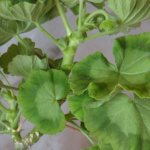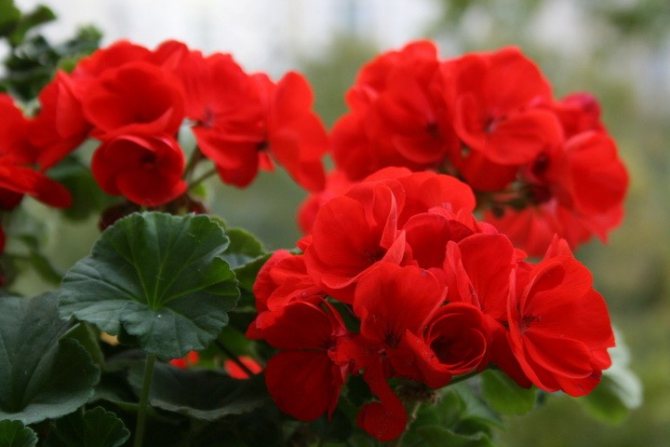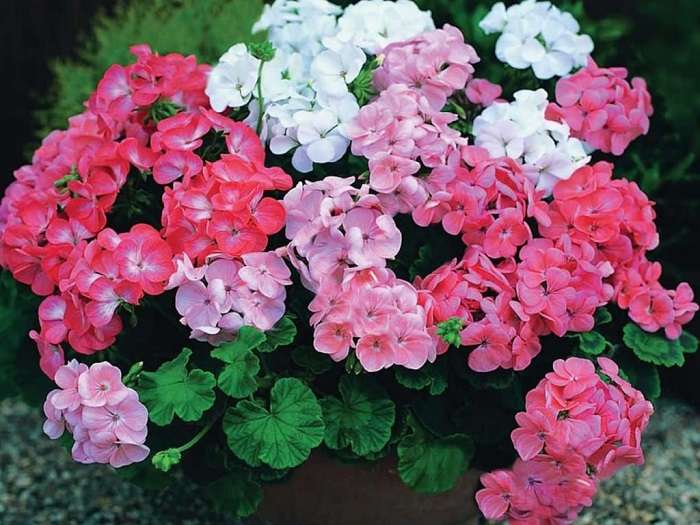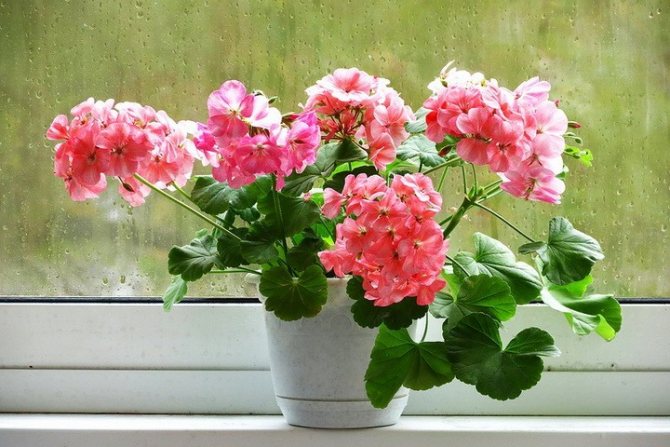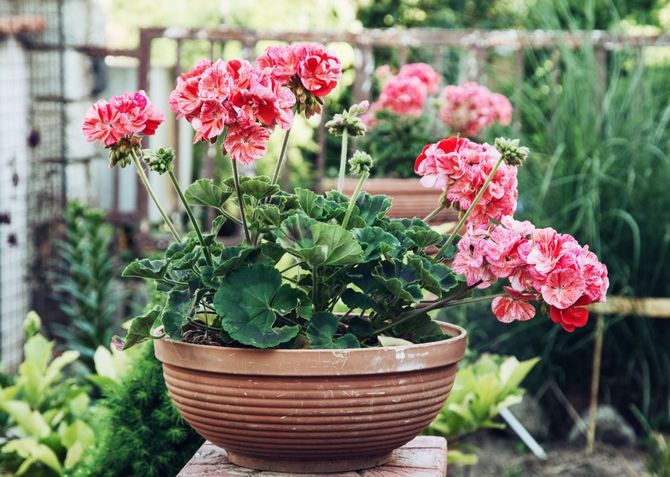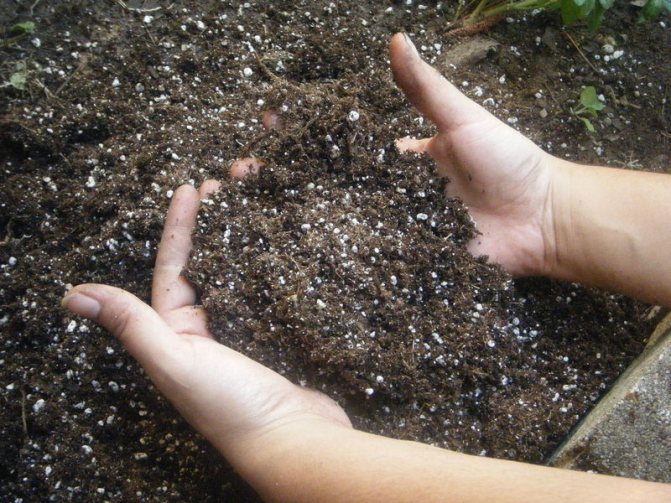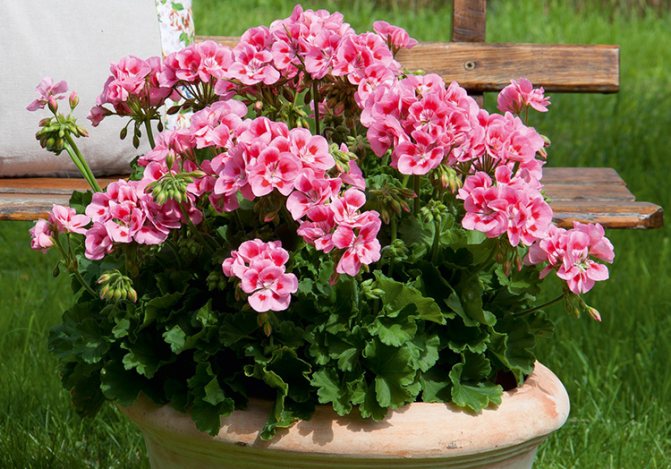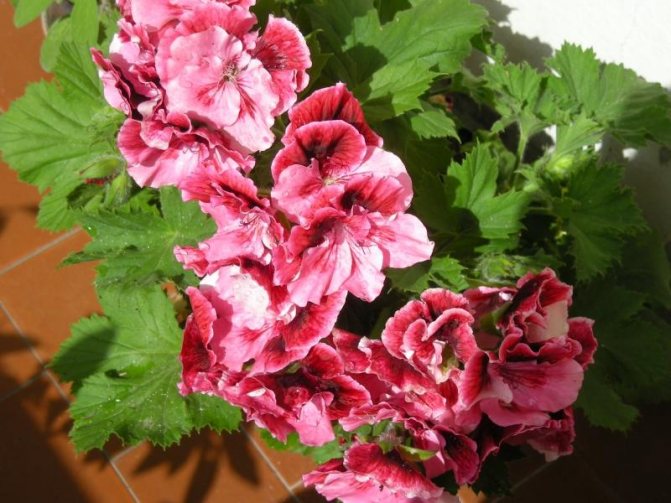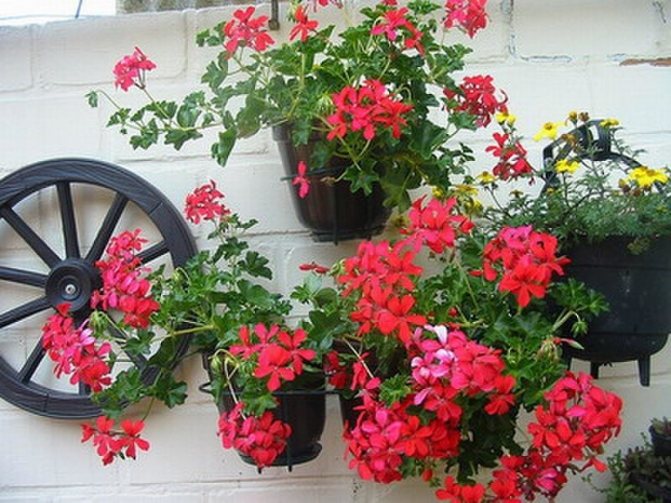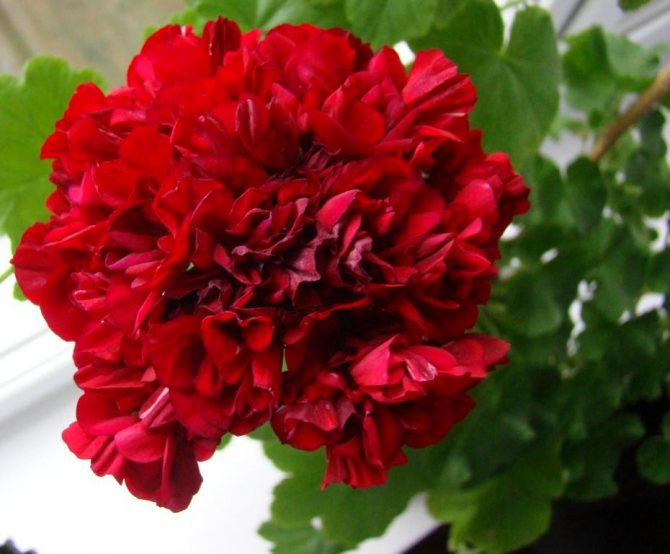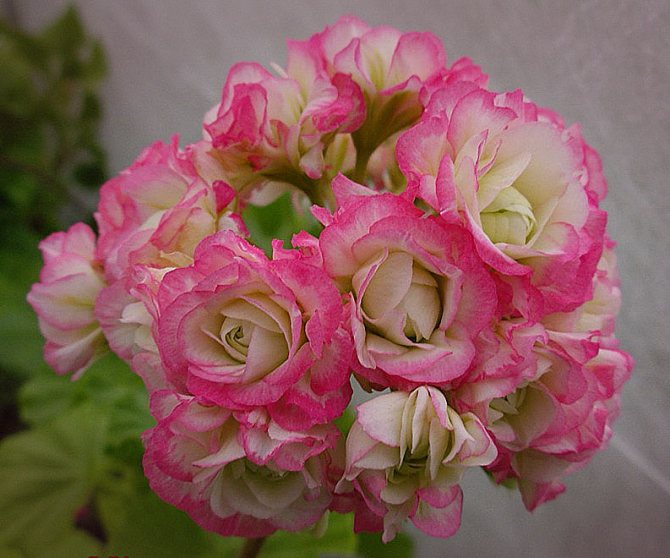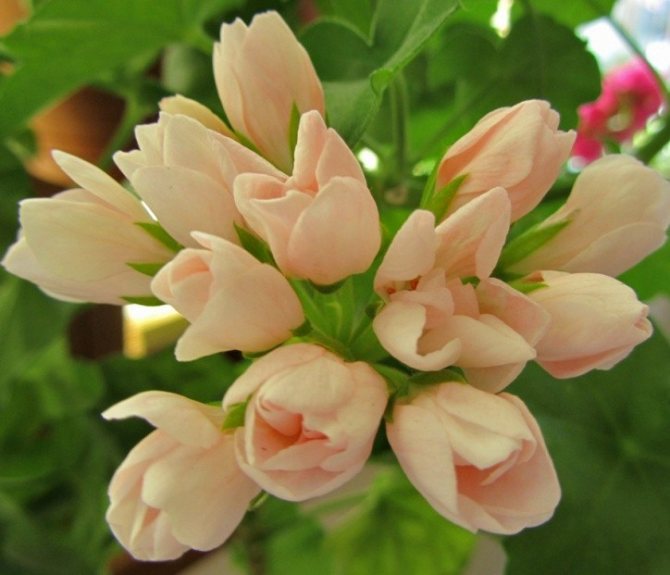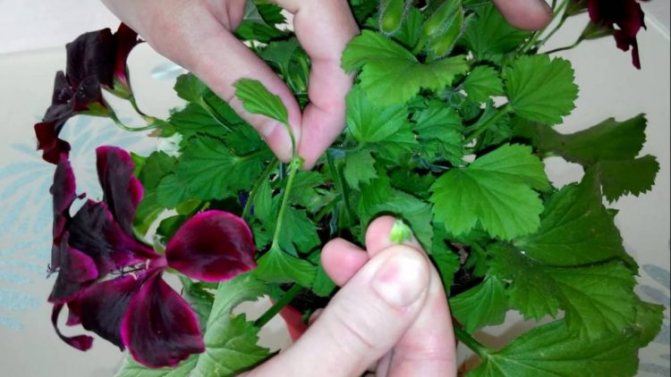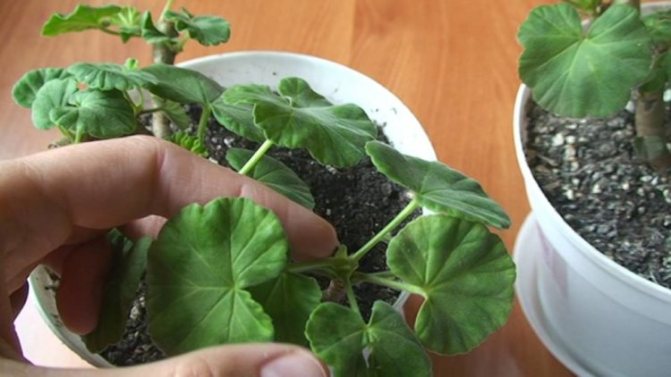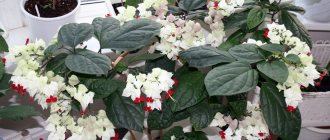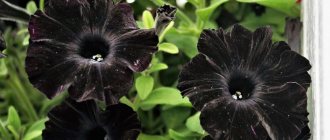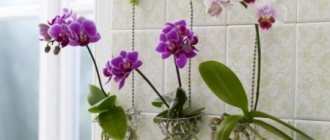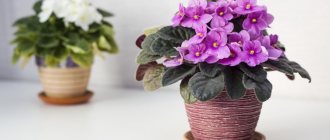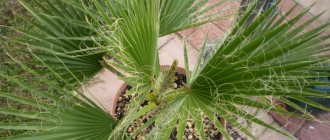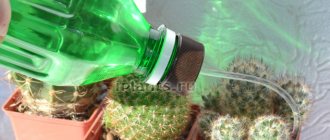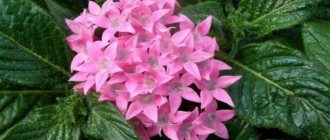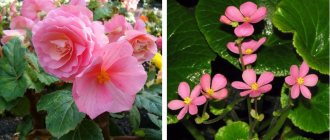Geranium (Pelargonium) is prized for its lush and very spectacular bloom that lasts for several months. But if the rules of care or the conditions of keeping at home are not followed, the bush will bloom very poorly, or inflorescences will not form on it at all. In this article I will try to name all the main reasons why indoor geranium does not bloom.
Why geraniums do not bloom: the main reasons
Geranium is a very unpretentious flower, which is very difficult to bring to a “non-flowering” state. However, such situations do arise, so it is necessary to know the root causes of the lack of budding. We will tell you in more detail why geranium does not bloom at home.
Incorrectly selected pot
Too large a pot in which geraniums are planted can negatively affect its flowering. A capacity several times larger than the size of the root system will be a signal for the plant to grow roots and leaves, filling all the empty space of the pot, and not to plant buds.
If you have several different pelargoniums, they can be planted in one bowl. Plants will begin to compete with each other, and flowering will not take long.
Depletion of the soil in the absence of fertilizing
No matter how fertile the soil in the pot is, the plant will eventually take away all the nutrients and trace elements from it. At home, transplants for an adult geranium are carried out once every 2 years. It is also recommended to fertilize the soil for its normal growth and flowering.
The introduction of potassium-phosphorus fertilizers has a positive effect on the quality and number of buds. Both liquid and granular formulations are suitable for flowering indoor plants with a high content of these elements. The recommended number of dressings is 1 time in 2 weeks, at the beginning of the laying of buds, the frequency can be increased, while reducing the concentration by 2 times. The dosage is usually indicated by the manufacturer on the package, but it must be reduced by 1/3.
Geranium also buds well when iodine is added to the soil. In order for the plant to receive the necessary trace element, it is necessary to prepare a solution of weak concentration - 1 drop of iodine per 1 liter of settled water.
Excessive watering
Waterlogging of the soil negatively affects the health of the plant - in addition to the absence of buds, geranium can shed foliage, wither and die altogether. That is why it is not recommended to overfill the soil, especially if there are no drainage holes in the pot.
The combination of highly moistened soil and low temperature is detrimental to the plant - over time, the root system of pelargonium will begin to rot. Geranium is even more sensitive to gulf than to dry soil. If you forgot to water the flower, it is quite capable of transferring it without water for several days.
When overdrying the soil, it is not recommended to water the geranium abundantly - water must be added in small portions several times.
Unsuitable soil
Since geraniums are native to South Africa, this plant is accustomed to harsh growing conditions. However, she feels very bad in clay soil. In such soil, water is retained for a long time, which negatively affects the root system of the plant.
Thus, an ideal soil for a flower should have the following characteristics:
- Well absorb and drain water;
- Have a neutral acidity level;
- Allow air to pass through and be light enough.
It is quite simple to comply with all these conditions - you need to use a special purchased substrate or prepare the mixture yourself. To do this, you need to mix:
- 2 pieces of garden land;
- 1 part of humus;
- 1 part sand.
At the bottom of the pot, a drainage layer is necessarily laid in order, for which expanded clay, crushed brick or ordinary foam plastic has proven itself well.
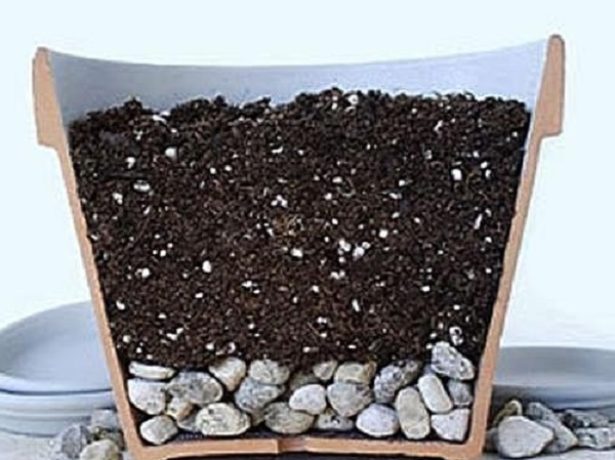
Failure to comply with the conditions during the rest period
The winter months for geraniums are a period of rest, when it accumulates strength for active life and flowering in spring. At this time, the movement of juices along the trunk of the plant slows down, photosynthesis becomes not so fast, the flower goes into "hibernation".
In order for geraniums to be able to sufficiently rest, it needs to provide the necessary conditions for this:
- Temperature range from +13 to +15 degrees Celsius;
- Rare and weak watering;
- Backlighting for at least 5 hours a day;
- Lack of drafts.
Improper wintering conditions can deprive you of bright inflorescences - geranium simply does not accumulate enough nutrients to form buds.
Lack of clipping
The decorative appearance of geranium and its flowering largely depends on the correct and timely pruning, which helps to form a compact crown. Pruning is carried out in the spring or in September. This helps not only to remove the extra branches that draw juices from the plant, but also to highlight the main ones, on which the flower buds are laid.
During pruning, dry geranium shoots and yellowed leaves are removed. All branches that do not grow from the root, but from the leaf sinuses, must be removed.
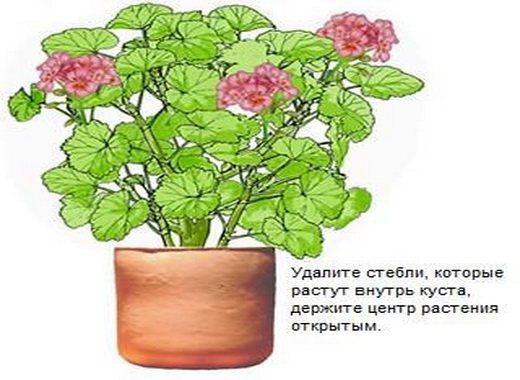

What care mistakes lead to a lack of flowering
Even the most unpretentious house flowers need attention and care. If this rule is not followed, problems with the plant are possible.


Here are the most common mistakes made by a grower that lead to the lack of flowering of indoor geraniums:
- Excessive watering. Pelargonium does not tolerate excess water and "swamps" in a pot. It tolerates minor drought much easier.
- Incorrect temperature conditions. The ideal temperature for a flower is 20 C. A significant excess of this indicator has a negative effect. In winter, a dormant period begins when the optimal thermometer value is 15 C.
- Container mismatch. If the geranium does not fit the size of the container, it starts up new shoots. As a result, all efforts are spent on growing leaves and branches. Small, compact pots are preferred.
- Lack of fertilizers. Pelargonium needs potassium supplements, but organic ones are not suitable.
- Lack of transplant. If the plant has not been transplanted into fresh soil for more than 2-3 years, there may be no flowers.
- Rare pruning. To preserve its decorative appearance, geraniums must be cut twice a year - in early spring and late autumn.
- Lack of light. When localized on the northern windows, the plant starts growing, as a result of which flowering suffers. It is best to place the pot in a well-lit area.
Proper organization of the content eliminates the problem. It is the failure to comply with the basics of care that causes the absence of flowers.
How to make geraniums bloom - tips and tricks
In order for geraniums to successfully plant buds, you need to know some tricks. They will help to achieve active budding.
- If several plants are planted in one pot, in spring the top layer of soil (3 cm) is replaced with fresh one. This will help boost your nutrient intake.
- Non-blooming geraniums can be rearranged on different windowsills in search of optimal lighting conditions.However, after the buds appear, the plant must be left in one place without moving it or changing the position of the leaves, as this can cause shedding of flower buds.
- A good fertilizer for geraniums is wood ash. The solution is prepared simply - for this, 1 tablespoon of ash is infused in 1 liter of water, which is then drained. To feed the plant, you need to take 1 spoonful of infusion and dilute in the required amount of water. By the way, this fertilizer is also used for the prevention of aphids.
- Pinching the tops of the stems after setting the buds will help geraniums to direct all their energies to flowering, and not to growing deciduous mass. It is also recommended to remove faded buds in a timely manner so that they do not draw out nutrients.
Flowering stimulation - transplant
The annual spring transplant of geraniums according to the standard scheme will have a positive effect on flowering:
- A drainage layer is placed on the bottom of the prepared pot;
- The plant is removed from the old pot along with an earthen lump, then the soil must be carefully removed;
- The root system of the flower is examined for rot and damage;
- If suspicious roots are identified, they are cut off with a sharp knife or scissors, and the cuts are processed with crushed activated carbon;
- The geranium root system is placed in a new pot, and the voids between the walls are filled with a slightly moistened soil mixture;
- Then the soil near the trunk is compacted with your fingers, the whole earth is watered abundantly;
- After that, the geranium must be placed in a darkened place for 1 week, then moved to a light windowsill.
After transplantation, pelargonium does not need feeding for 2-3 months. The rest of the care of the plant remains the same.
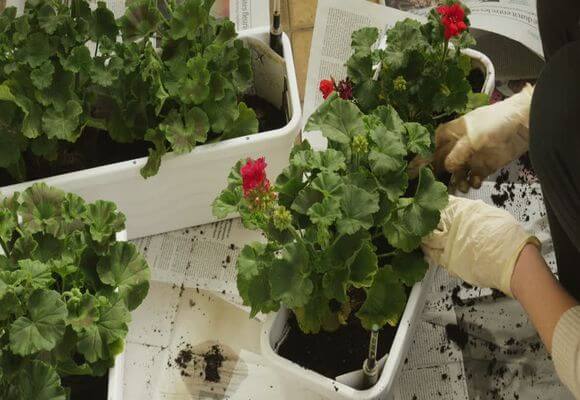

How to conduct it correctly?
The algorithm of actions is as follows:
- Before starting the pinching, carefully examine the upper shoots of the flower and find the growth point on them, the largest upper shoot bud, which is responsible for the active growth of the plant. If this point is not removed in time, the begonia will stretch in height, preventing the formation of side branches.
- When you find the main active kidney, pinch it off gently with your fingers or nails. On a denser, woody shoot, you can use nail clippers or garden pruning shears. When carrying out the procedure, make sure that the neighboring young leaves do not wrinkle, and try not to break the main stem of the shoot.
- After pinching, the shoot does not stop growing in height completely, and after a while it will begin to stretch again. But thanks to pinching, the lateral buds will have time to open and sprout new shoots.
- Remember that removing the top shoot will cause nearby dormant buds to wake up. Therefore, if you do not want the emergence of shoots in these places, the buds have awakened. After the first shoots appear, they must also be carefully removed.
Important points:
- When working, use only clean, alcohol-treated tools. Pruning shears or scissors should be well sharpened so as not to unnecessarily injure the flower. Hands must be washed thoroughly so as not to infect the geranium with any disease.
- If the pinching is carried out with nails, without using a tool, the shoots cannot be pulled too much, as this will injure the plant.
- After the end of all procedures, the flower should be placed in a warm, sunny place. Young shoots need plenty of light to grow quickly and vigorously.
- If unhealthy, infected shoots appear on the plant, they must be immediately removed from the 3-4 cm part of a healthy trunk.
- The pinching points must be treated with disinfecting substances: alcohol, brilliant green or charcoal ash. Otherwise, the cut sites will begin to dry out, and pelargonium can get sick.
Radical ways to make geraniums bloom
And if you have organized all the necessary conditions for a flower, but pelargonium still does not please with a large number of buds? In this case, to make it bloom, you can apply "shock therapy":
- Landing in open ground... It is carried out in late spring or early summer - the plant needs to be transplanted from a pot to a flower bed or garden bed. Until autumn, geraniums are gaining nutrients, growing deciduous mass, in September they are placed back in the pot.
- Strong pruning... It will help to achieve a large number of buds and cut the stems in a radical way. For this, only 2-3 eyes are left on each branch.
By organizing such "unfavorable" conditions for the growth of pelargonium at home, you will achieve its active budding - the plant will simply be forced to bloom for further reproduction.
Why does pelargonium not bloom indoors?
Geranium is a herbaceous perennial plant that can be easily grown at home. There are more than two hundred varieties in nature. Natural habitat - South Africa.
In our latitudes, a flower is planted in flower beds in parks and gardens, cafes, gazebos and balconies are decorated with hanging pots. There are species with smooth and double petals. The colors can be very diverse.
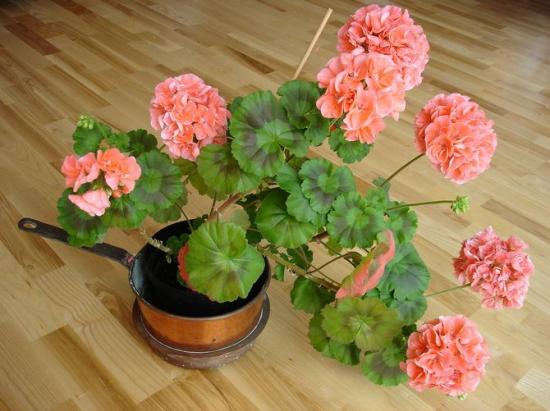

At home, fragrant and flowering varieties of pelargonium are grown. The former have a pleasant aroma, but their flowers are small and faded. The advantage of the latter is abundant, long-lasting and lush flowering. The lifespan of a houseplant is about 10 years.
What time does geranium bloom? The plant pleases with flowers almost all year round - from spring to late autumn.
Since in nature, pelargonium can grow in rather harsh conditions, home care should not be difficult. It happens that the owner cannot wait for flowering for a long time.
Fungal or bacterial diseases may be to blame, but in this case, the owner will notice a general deterioration in appearance. The problem disappears as you recover. In severe cases (especially with decay), the death of the plant occurs.
However, the most common reason for the lack of flowers is improper care.
Some owners believe that the plant only needs watering to grow successfully. Next, we will consider how pelargonium should be contained.
Flowering features
The flowering period is the process of sexual reproduction of plants., consisting of several successive stages.
- The laying of flower buds in the buds.
- The appearance of flowers, their pollination and flowering.
- Seed formation. The most important stage for geraniums to continue to exist.
How long is this period?
With proper care, the flowering period of geraniums lasts from early spring to mid-winter. Some representatives of the plant bloom well all year round.
Features of the appearance of buds, what happens to the plant at this time?
When Pelargonium royal awakens after a dormant period, it begins to accumulate strength for future flowering. The reproductive organs of the flower are formed in the buds that are being laid... An umbrella with buds appears from the bud. At the time of breeding, they open up. Flowers wither after pollination.
Attention! Flowering is the main feature of the plant during the reproduction process. During the entire life cycle, at this particular time, pelargonium consumes the greatest amount of energy. Metabolic processes are much faster, and the consumption and processing of nutrients is also increasing.
Necessary home conditions for the formation of buds
To create a comfortable existence for geraniums, it is important to choose suitable home conditions:
- Pot. Geranium loves small pots. In spacious pots, it gains green and root mass.
- The soil. Geranium prefers fertile soil.
- Drainage. Water stagnation should not be allowed, this can lead to root decay.
- Lighting. The place to grow the flower should be light and warm. If geranium is located on a windowsill, it should be protected from direct sunlight. Under the scorching sun, the plant will very quickly lose its decorative effect.
- Fertilizers. Lack of nutrients leads to wilting of the plant. Leaves may turn yellow and fall off (why may a flowering geranium not grow leaves?). Potash and phosphorus fertilizers are suitable as top dressing.
When using complex fertilizers, you should pay attention to the nitrogen content in them. It should be in the composition of no more than 11 percent. Otherwise, geranium builds up lush greenery and does not bloom. It is advisable to feed it once a week.
Why and when do you need a pinch?
Geranium, or as it is also called pelargonium, is a perennial plant that blooms for a long time and magnificently. The flower has many medicinal properties and is practically not afraid of pests, which it repels with its specific smell. We meet geraniums not only in gardens and flower beds, but also on many window sills.
Due to its unpretentiousness and beautiful flowering, geranium has gained great popularity in our country. But to keep this beautiful flower compact and attractive. And it did not take up half of the window sill, you need to properly care for it, do timely pinching and cutting (how to care for geraniums at home in a pot to bloom, read here, and from this article you will learn about recommendations for caring for a flower in open ground). Using these simple geranium shaping tricks, you will achieve two important goals:
- Timely pinching will allow the plant to bloom beautifully and profusely.
- In addition, pinching and pruning geraniums will rid the plant of diseased and weak branches that slow down the growth and development of the flower.
Therefore, this procedure can be used as a regulator of the timing of flower flowering. You need to stop pinching the plant after it acquires the desired shape and bushiness.
The essence of the procedure
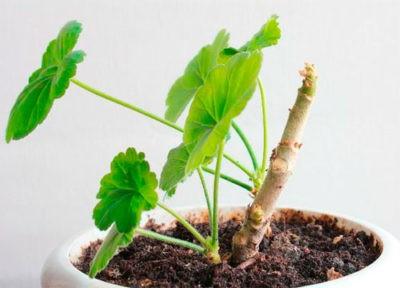

The principle of plucking is to remove the growth point from which a new branch occurs. Simply put, the very top of the geranium stem is cut off. This procedure forces the trunk to sprout more and more, and the flower becomes more and more branched.
Pinching young pelargonium should be done several times a month, while the flower grows in growth and gains strength. Usually all leaves on the stem are removed, except for 5-6 of the largest and strongest leaves.
You can pinch growth points in any months of the year, except for the winter months, when the plant needs to rest and should not be disturbed (you can find out how to care for home geraniums in winter here).
Plant care
Consider how to properly take care of geraniums so that it blooms all year round or in the country all summer, how to care for it to bloom better.
What needs to be done to make it bloom in spring?
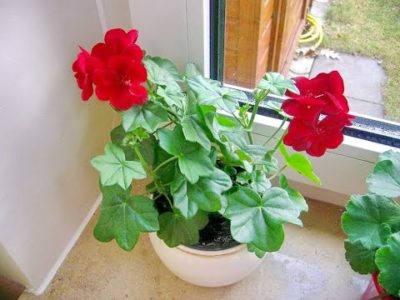

In the spring of geraniums, a transplant is needed (can you transplant during the flowering period?). During this period, the necessary nutrients are laid in the geranium. Geranium is quite sensitive to this procedure, so you just need to transfer it to a new pot of slightly larger volume. It is advisable to add magnesium sulfate and nitrogen to the store soil.
If the soil mixture is prepared independently, then it is necessary to lay in it a full range of mineral fertilizers. For this, granular dressings of prolonged action are suitable. They must be mixed with earth during transplanting. Over time, they will dissolve in the soil, giving nutrients to the plant for a long time.
How to get the buds all year round?
It is possible to extend the flowering period by cutting off faded inflorescences. Correct pruning stimulates geraniums well for vigorous growth and future flowering. After autumn pruning, only 2-3 eyes may remain. There is nothing wrong with that.Only after it is necessary to leave the geranium in a cool room until January.
The plant should rest. Already in January, geraniums can be moved to a warm room. After the plant grows, it should be pinched.
What to do to bloom on the street or in the country all summer?
The most important condition for favorable flowering is the right choice of planting site. Geranium prefers sunny areas. For lush flowering all summer, the plant should be slightly shaded. The soil must be fertile and well-drained. Loamy and clayey soils are not at all suitable for geraniums.
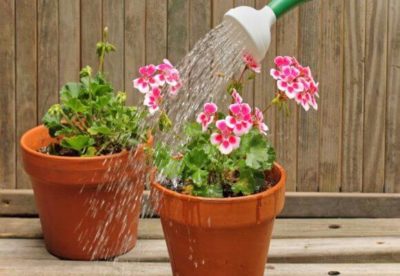

For abundant and long-term flowering, you should provide the plant with regular watering.
With insufficient soil moisture, the flowers will be small or not at all.
It is imperative to remove faded inflorescences from geraniums. Removing them will provide maximum decorative effect all summer long. Pruning is an equally important factor. It promotes the appearance of side shoots. Before flowering, it is advisable to apply fertilizers to the soil, which contain a high content of phosphorus. This will help create a lush and dense bush.
For the formation of a large number of large inflorescences, it is advisable to apply potash fertilizers. It is necessary to feed once every two weeks during the period of inflorescence formation and during their active growth.
The necessary conditions
- Temperature... One of the most important indicators, the requirements of which differ depending on the season. In winter, the temperature regime should be within +13 +15 degrees. This will allow the flower to remain in what is called a dormant state. When pelargonium begins to grow actively, keep it at a temperature of +18 .. + 23 degrees. Intense heat negatively affects the pet. In no case should drafts be allowed.
- Humidity... The appearance of various types of diseases often provokes dry and hot air near heating devices. But excessive moisture is also undesirable. Optimum rates are from 40% to 60%.
- Lighting... In winter, the sunlight becomes much less, which is what pelargonium requires. Short daylight hours with diffused lighting are ideal for a plant. Bright and long-lasting rays of the sun can contribute to the disruption of biorhythms. At the time of growth and flowering, pelargonium prefers more sun. Elongated shoots and faded foliage are a clear sign of a lack of lighting.
- The soil... For royal pelargonium, a fertile and loose earth is needed, with a neutral or slightly acidic reaction. Loamy and clayey soil is not suitable. There must be a good drainage layer at the bottom of the pot.
Important! During cold weather, you need to carefully monitor the temperature of the soil, because it can differ from the temperature of the surrounding air. This phenomenon is observed on cold windowsills. The situation can be easily corrected by placing a small piece of insulating material under the container with a flower. - Pot... The main requirement for the container is the correspondence between its volume and the size of the roots. Pelargonium should be transplanted when the root system is cramped. If the flower was planted in a large pot, then flowering will not come soon, since all the energy will be spent on the development of space. The new container is selected only 2-3 centimeters larger in diameter than the previous one.
How to make the plant bloom profusely and luxuriantly?
Sometimes, if all the conditions are met, geraniums may still refuse to bloom. It is possible to force her to do this only under the threat of existence. There are several known ways to make a plant bloom.
- Provide a cool wintering without food and watering. Having withstood such conditions in winter, when transferred to a warm room with the arrival of spring, geranium will certainly bloom.
- Move the geranium to a room with sudden temperature changes. A balcony or a transplant to a garden will do.Freezing and drafts should be avoided.
- It is worth trying to move the geranium to another place. It is quite possible that the conditions created simply do not suit her.
Can be applied to one flower at a time, no more than 50 ml of solution. Iodine injections should be administered after irrigation with plain water. Moist soil will prevent root burns from the mortar.
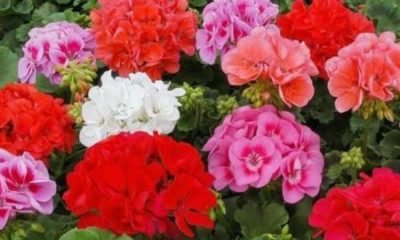

One great method of her is ash extraction. To do this, place one spoonful of wood ash in 1 liter of water and let it brew, drain the excess liquid and use it for watering in a diluted form.- allow water to enter the buds and inflorescences;
- treat the plant from pests.
It should be understood that the use of these methods is possible only for healthy plants. Diseased flowers do not need to bloom. It must be immediately rescued from fungal or viral diseases, as well as pests.
Dampness and moisture can lead to fungal diseases, black or root rot. This disease is quite difficult to fight. Therefore, experienced gardeners advise beginners to immediately destroy infected flowers so that all other flowers in the house do not get sick. If you are not afraid for neighboring flowers, you can try to cure geraniums with fungicides.
The main pests that affect geraniums include whitefly, aphids, spider mites. You can destroy them by wiping with soapy water, alcohol or special means. against every single type of parasite.
During the flowering of geraniums, you cannot:
In the video we will learn how to make geraniums bloom profusely and for a long time:
Daily inspection and provision of all the necessary conditions for the existence of a plant is the key to a lush and long flowering.
If you find an error, please select a piece of text and press Ctrl + Enter.
Pruning and transplanting rules
Mandatory procedures for caring for geraniums are pruning and transplanting. Pinching is carried out in the fall and spring. Each period has its own characteristics.
Spring pruning
In spring, the procedure is carried out in late winter or early spring using a sharp, disinfected knife. Light pruning promotes greenery change and flower formation. Even a slight pinching delays flowering for several weeks, but the flowers are lush and large.
Pruning too intensively can eliminate the formation of inflorescences this year, so do not overdo it.
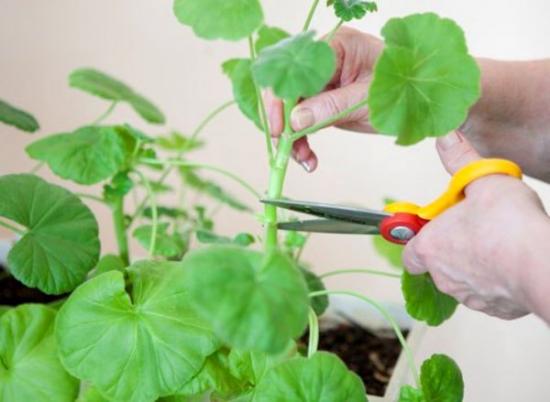

Autumn pruning
In the fall, geraniums are pruned after flowering is complete. First, dried inflorescences, leaves and stems are removed. Then, too long and weak branches are shortened, giving the plant the desired shape. Professionals recommend shortening the shoots by 1/3 before the dormant period. In winter, geraniums are not pinched.
Transfer
The transplant is an equally important part of the care. It is carried out every two years until the beginning of the active growth phase (in spring). Consider the following points:
We choose the container 1.5-2 cm larger than the previous one.
As a soil, a mixture is used that includes sand and a universal substrate (or garden soil) in a ratio of 1: 2. Drainage is placed at the bottom.
After transplanting, the plant is fertilized with potash or potassium-phosphorus fertilizers.
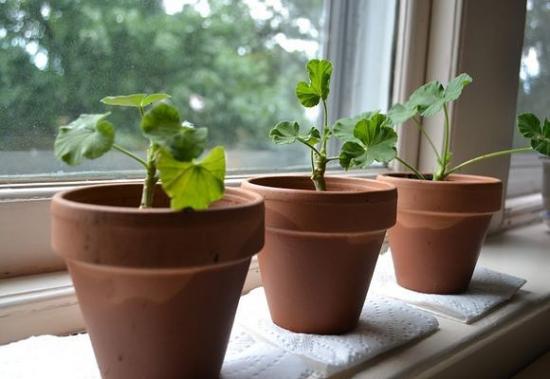

For better rooting, the flower is placed in a warm room with diffused sunlight.
What to do to make geranium bloom? Do not neglect such important procedures as transplanting and pruning, and the plant will delight you with a beautiful appearance.
Geranium - description
The plant, which is commonly called geranium, is actually pelargonium. She belongs to the geranium family. The name "Pelargonium" is translated from Greek as "Stork", because of the similarity of its fruits to the beak of a stork.
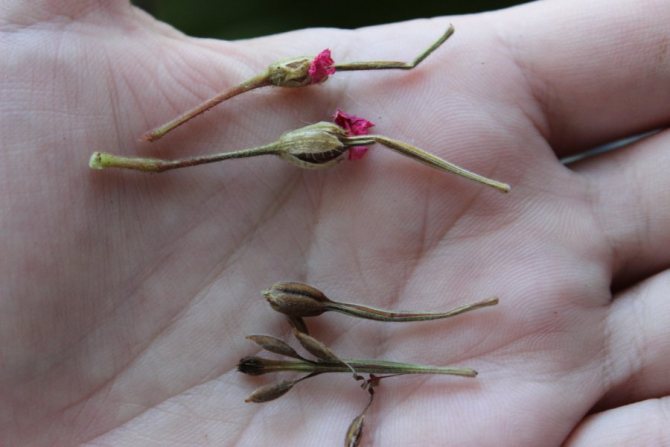

Pelargonium fruit resembles a stork's beak
Real geranium is a plant that can often be found in forest or meadow areas. There are bred varieties for garden cultivation that winter well without shelter.
Some types of geraniums in the photo
Geraniums grow very quickly. Most species can be grown from seeds. With autumn-winter sowing, they bloom already in the first year.
The geranium family unites 5 genera and 800 plant species. Geranium leaves are beautifully carved, in many species they are fragrant. Leaf colors: green, variegated, with yellow veins, with red and yellow tints.
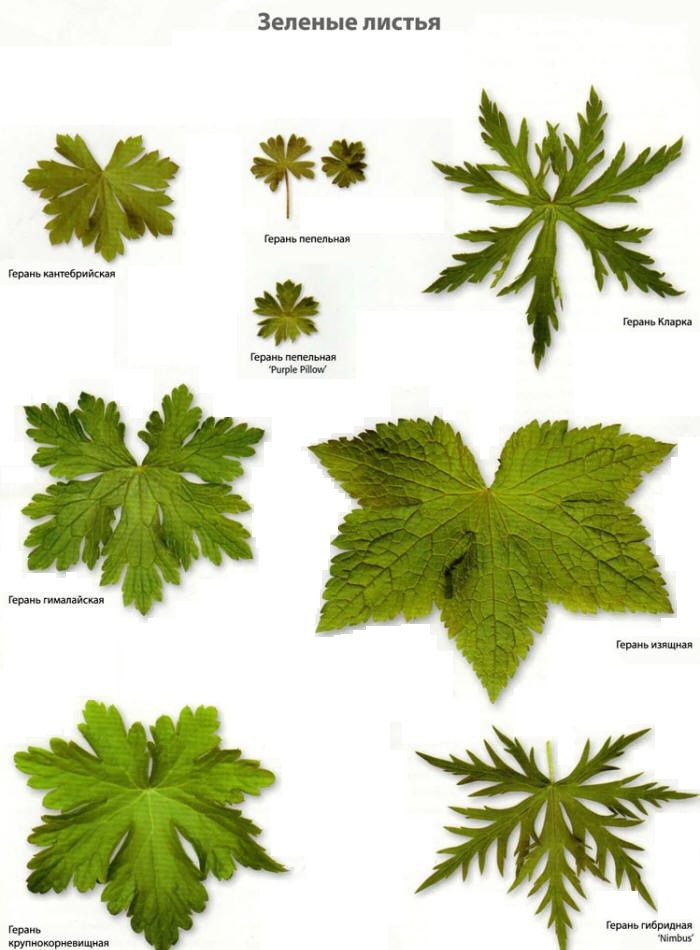

Green leaves of different shapes
Geraniums are an excellent antiseptic, have anti-inflammatory and other medicinal properties. Various extracts and essential oils are made from them.
It is very useful to keep pelargoniums at home, they disinfect and purify the air, and also scare away flies, moths and mosquitoes. Aromatic leaves can be added to tea (dry).
The smells of such fragrant geraniums are so diverse that they can resemble anything: an apple, a rose, citrus fruits, conifers, caramel, pineapple, coconut, wormwood, and so on! Most of them do not bloom as brightly as other pelargoniums, but more than make up for this deficiency with their unique and healthy aromas.
Indoor pelargoniums are mainly divided into four types: zonal, thyroid (ampelous), royal (large-flowered), fragrant (aromatic). There are a large number of varieties and hybrids of pelargonium.
Pelargonium - gallery
What to do to make the bush grow thicker?
This stimulates the growth of lateral buds at the lower nodes of the stem. After this event, the seedlings will slow down their growth, but will begin to gain strength. Geraniums will eventually develop a beautiful spherical shape due to the appearance of a large number of lateral stems.
How to prevent the flower from stretching up too much?
So that the geranium does not stretch out in growth, the pinching should be done at the most important top point of the stem formation. If, after this procedure, the shoots start growing again from the upper axils of the leaves, they must be removed, then allowed to grow a little and pinched again. The buds are removed during this time so that the flower gives all its strength only to the growth of lateral shoots.
Pelargonium bloom
Pelargoniums bloom from spring to the onset of frost. The decorativeness of these plants lasts on average for five years. But with proper care, adherence to dormant times and proper pruning, pelargonium can live and bloom for more than 10 years.
Comfortable temperature for flowering pelargonium is from + 22 to + 27 o C.
For long-term flowering you need:
- at the beginning of plant growth above the fifth leaf, pinch for the correct formation of the bush;
- do not plant in a pot that is too spacious, adding size only as the root system grows;
- place pelargonium on the east and south windows;
- avoid flooding the soil;
- cut off the yellow leaves;
- to pick off fading inflorescences;
- do not overfeed the plant, especially nitrogen;
- once a week add iodine to the water for irrigation: 1 drop of iodine per liter of water, 50 ml of solution for each plant;
- ventilate plants in summer, protecting from cold drafts;
- when flowering, try not to rearrange the plant often.
Placing pelargoniums on the north and west windows significantly impairs flowering.
Pelargoniums need an abundance of light, but still need to protect them from direct sunlight. Otherwise, the leaves may get burned.
With a lack of lighting, the plants stretch out and stop blooming. Therefore, it is better to put them not in the back of the room, but in the brightest place.
If you do not have the opportunity to provide good lighting to pelargonium, then buy phytolamps for supplementary lighting, or ordinary fluorescent lamps with a yellow spectrum.
Daylight hours for pelargonium during flowering should be 12-14 hours.
When is it necessary?
The great popularity of geranium is due to the fact that it is unpretentious in care and has a very beautiful decorative bush. with large caps of flowers.But in order for this plant to please the eye with its buds, while the bush was attractive, while not taking up much space - care must contain a mandatory, timely pinching.
If you carry out this procedure correctly, you can get the following:
- abundant, lush and beautiful flowering;
- removal of elongated, diseased, weak shoots that prevent the plant from growing and developing well;
- getting a compact bush.
The pinching begins as soon as the period of active growth begins - the end of March, the beginning of April. It is possible to form a bush within 2 months, while all inflorescences are removed from the geranium.
Planting a flower, soil properties
If you want your pelargonium to bloom for a long time and abundantly, you need to take care of this from the very planting.
It is advisable to transplant pelargonium only when the root system overgrows, without damaging the earthen coma around the roots.


It is best not to transplant pelargonium, but to transfer it without damaging the earthen lump around the roots.
Planting, or transshipment, can be done in early spring, before flowering begins. When planting, ensure good drainage (2–2.5 cm). There should be drain holes at the bottom of the pot.
Suitable as drainage: pebbles, expanded clay, large perlite.
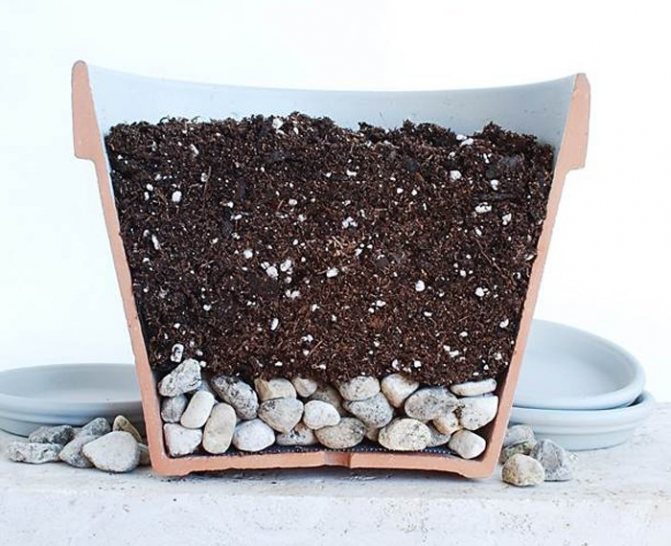

There should be drainage and drainage holes at the bottom of the pot
Plant pelargonium closely enough, you can have several bushes in one pot. Then the plant will not spend a lot of energy on the growth of the root system, but will spend it on flowering.
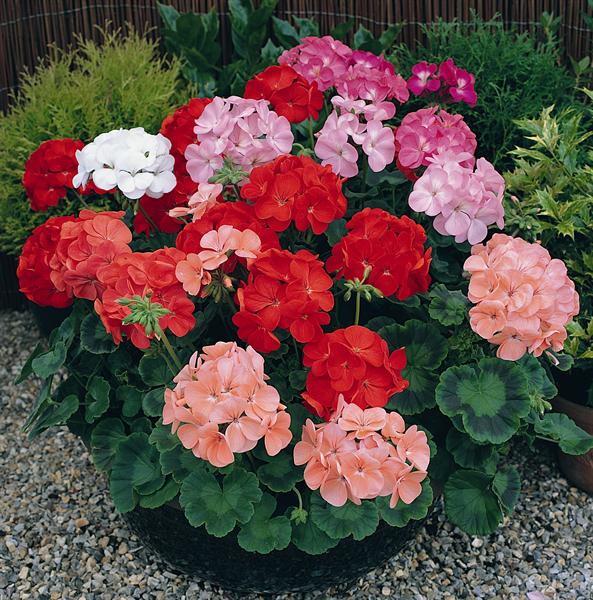

Several bushes bloom perfectly in one pot
Soil compositions for pelargonium
- Universal soil 10 parts + chopped sphagnum 1 part + sand 1 part + humus 0.5 part.
- Loam 2 parts + soil with peat and fertilizers 2 parts + coarse perlite 1 part + sand 1 part.
- Deciduous soil 2 parts + loam 1 part + peat 1 part + crushed bark 1 part + compost / humus 0.5 parts + perlite 1 part.
- Sod land 2 parts + sand 1 part + humus 1 part.
When compiling and choosing a soil, be guided by the fact that it should be light enough, nutritious, neutral or slightly acidic.
Soil is considered neutral if it does not contain chalk, limestone and other minerals. Slightly acidic is, for example, leafy soil and peat. Sour - coniferous litter.
What can be added to the soil
- Peat: nutrition and breathability. If there is an excess of it, the soil will dry out too quickly. Quality peat is brown.
- Loam serves to retain moisture and nutrients. Excess leads to soil compaction.
- Perlite loosens the soil, accumulates excess minerals and, if lacking, gives them to plants. Use large.
- The sand loosens the earth, prevents it from caking. Disinfect it before adding.
- Charcoal is antiseptic and nutritional. Add 1/4 of the total amount of soil.
- Sphagnum: Moss that retains moisture, is breathable, has antibacterial properties. When added to soil, it must be cut into 1–2 cm pieces.
- Humus / compost: fertilizing and loosening the soil. Add no more than 1 part of the total. When planting, instead of humus, you can put a dry (!) Cow cake on the bottom of the pot. You cannot add fresh organic matter!
- Shredded bark: breathable, loosening.
There are ready-made soils on sale: "For pelargoniums", "For geraniums".
What is it and why is it needed?
Pinching - removing the top shoot growth point mechanically in order to stimulate the growth of lateral layers, increase the volume and bushiness.
- You can carry out the process with your hands, removing the upper part of the shoot, with small scissors or a sharp blade.
- A correctly carried out process will allow you to get not only a beautiful, compact bush, but also to achieve long-term abundant flowering.
- Simply put, the top is cut from the stem of the geranium, which is responsible for its growth upward.
- After this procedure, all the forces of the plant are directed to awakening the dormant buds, which are located in the internodes. As a result, the main stem becomes branched.
- The pinching is carried out during the active growing season several times a month, until the plant acquires a certain shape conceived by the hostess.
- In most cases, the foliage is removed from the stem, leaving 4-6 of the largest and strongest.
The growth point can be removed from the shoot at any time, except for the winter period - at this time a dormant period begins.
If you follow the step-by-step instructions for pinching a plant, it will look like the photo below.
Top dressing at home
Pelargonium is fed from March to November 2-3 times a month.
In the first year of planting, it is enough to fertilize the plant with only nitrogen fertilizer for good growth. It is best to use ammonia for this: half a teaspoon per liter of water.
In the future, the nitrogen content in fertilizers should not exceed 11%. The abundance of nitrogen in the soil leads to the growth of the green mass of the plant and stops its flowering.
For good flowering of pelargonium, fertilizing is necessary, containing mainly phosphorus and potassium.
It is best to use ready-made formulations for pelargoniums or geraniums for feeding. Fertilizers are also suitable for plants such as: petunias, begonias, violets.
During flowering, can be fed with fertilizer for flowering plants. Follow the manufacturer's directions for dosing.
- A very good fertilizer for pelargonium is made from ash. Insist a tablespoon of chopped wood ash in a liter of hot water for 3 hours. Consumption: one tablespoon of infusion per plant. Stir the infusion before use.
For a spring transplant, you can add a pinch of granular rose fertilizer to the soil.
When does it bloom?
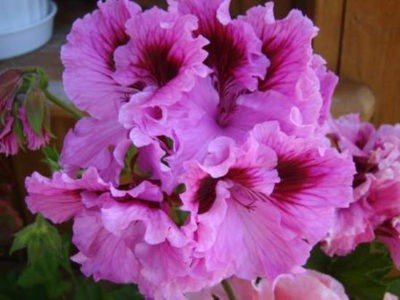

Although royal pelargonium is distinguished by its lush and unique flowering, its timing is very modest. For example, common pelargonium blooms in early spring and withers in late autumn... Royal, however, pleases the eye only 3-4 months a year. The approximate flowering time is April-August.
The pet is quite capricious and, with improper care, may not bloom at all. In order to avoid trouble, before buying, you should carefully study this species (read about what varieties this type of pelargonium has here).
Plant care to achieve profuse flowering
The main thing when caring for pelargonium:
- do not flood the soil;
- make pruning on time;
- observe the rest mode in the winter.
Waterlogging of the soil leads to decay of the root system, and the lack of pruning and adherence to dormancy reduces or stops flowering.
It is necessary to water pelargonium in the summer as the soil layer dries out by half, in the winter - after it has completely dried out. You can check this with a wooden stick (for example, a bamboo skewer).
When watering, the soil is well spilled, removing water from the pan. You need to water gently from a watering can, without getting on the leaves. It is all the more unnecessary to wet the flowers.
If you have hard water with lime deposits, it is better to use boiled or bottled water for irrigation.
If the air is too dry, do not spray pelargonium, but place dishes with water next to it.
Features for seed-grown pelargonium
Grown geraniums from seeds need to begin to pinch over 6-8 leaves. This leaves only axillary shoots growing below the uppermost pair of leaves. If, after pinching, shoots begin to reappear in the axils of the upper leaves, they must be removed immediately, otherwise new shoots will not begin to grow in the lower axils.
Below you can see step-by-step photos of the process of pinching geraniums.
Bookmark Secrets of Lush Geranium Blossom 284
FOR GERANIUM PLEASED WITH LUXURY BLOSSOMING


You can also grow geraniums from seeds, but grafting, which is carried out from mid-February to early March, is preferable.
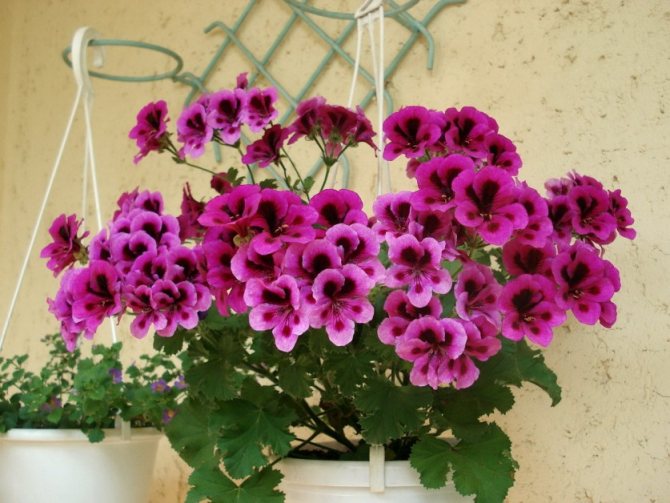

At this time, it is already required to prune geraniums. After all, geranium is photophilous, and in winter there is little light, and the plant stretches out, becomes not very beautiful.
In geraniums, you need to cut the bare shoots to the height that you need (but not quite to the stump, of course), new branches will go from them.
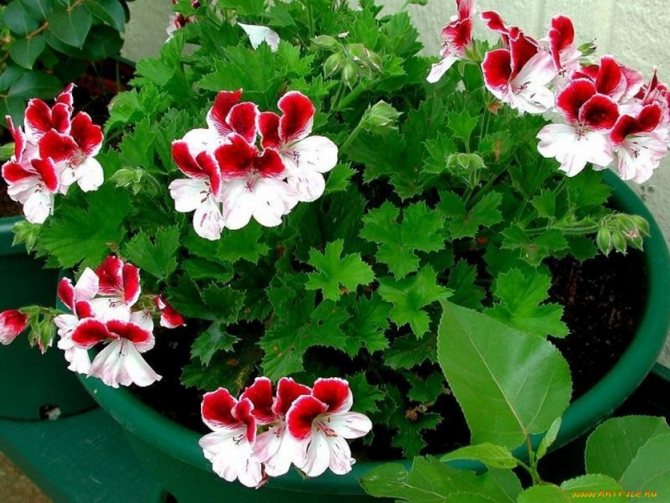

And you can renew the geranium every year by replanting from a new cuttings, as our great-grandmothers did in the old days.
For propagation of geraniums, apical cuttings about 7 cm long with 3-5 leaves are suitable.
Cut the cuttings, making an oblique cut under the bud, cut off the bottom pair of leaves, dry the cut and the place where the leaves break for 2-3 hours so that the cut is tightened with a film, and plant immediately in prepared pots with soil, lightly water.
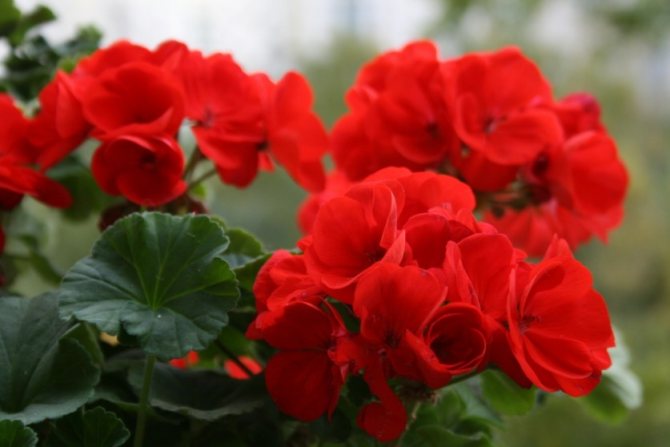

To form a lush bush, pinch the apical bud. We put in a bright place, but not in the sun!
Many simply cut the cuttings and put them in water, you can put activated carbon tablets in a jar of water so that there is no decay.
Roots form very quickly. Then they are placed in pots.
You need to take a small pot. You don't need a lot of geranium land. The faster the roots cover a clod of earth, the faster the plant will bloom, and the smaller the pot, the more abundant the flowering will be.
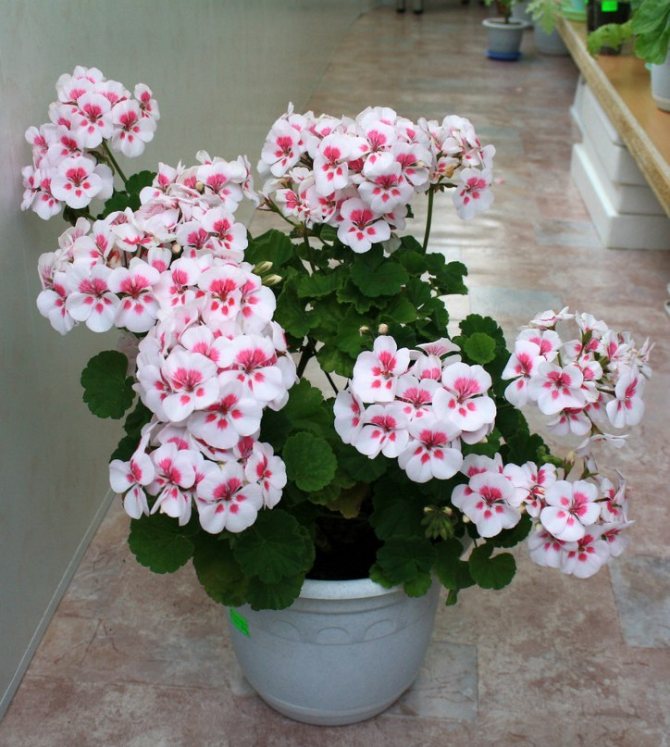

In large pots, the plant may not bloom at all, it does not need it - life is so good, why bother? You can even plant several cuttings in one pot.
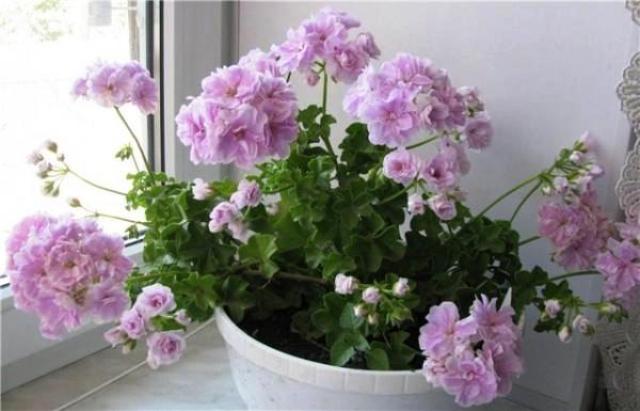

In the process of rooting, the lower leaves may turn yellow - tear them off when a couple of new leaves appear.
To form a beautiful lush bush, pinch the top on the 8-10th leaf, the side shoots - on the 6-8th and constantly turn the pot so that the bush is even.
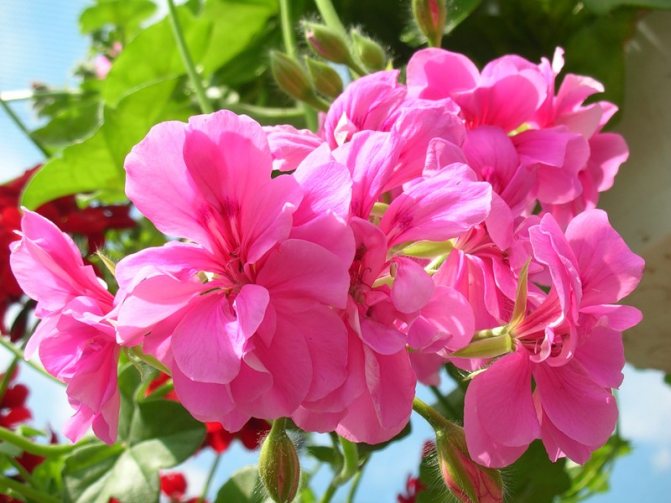

Geranium loves: - the sun (but also tolerates a light shade); - warm (but will survive very light autumn frosts); - not frequent, but abundant watering; - good drainage in the pot; - moderately fertile, even poor soil (otherwise there will be a lot of greenery, but few flowers); - regular feeding; - removal of faded inflorescences to continue flowering.
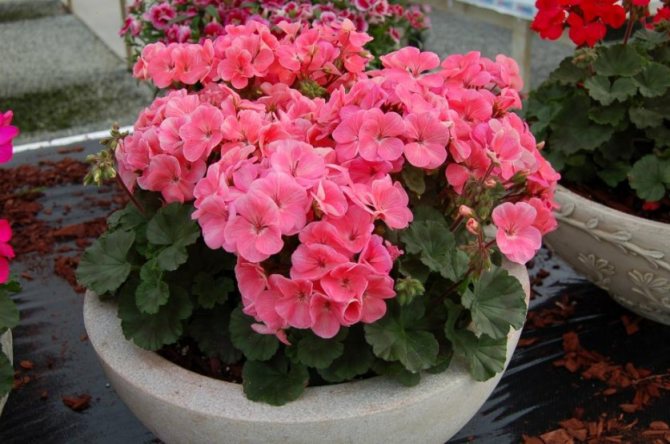

In June-July, if necessary, cuttings can be made.
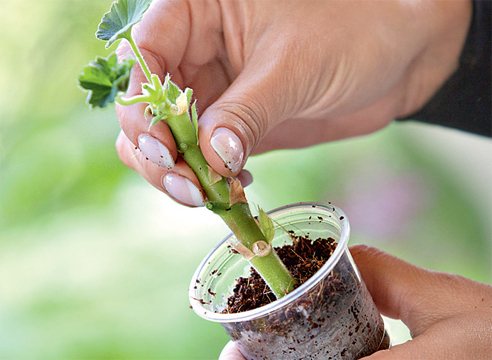

ABOUT
iodine water is a very good feeding:Dissolve 1 drop of iodine in 1 liter of water and pour 50 ml of this composition over the walls of the pot. Do not overdo it so the roots do not burn!
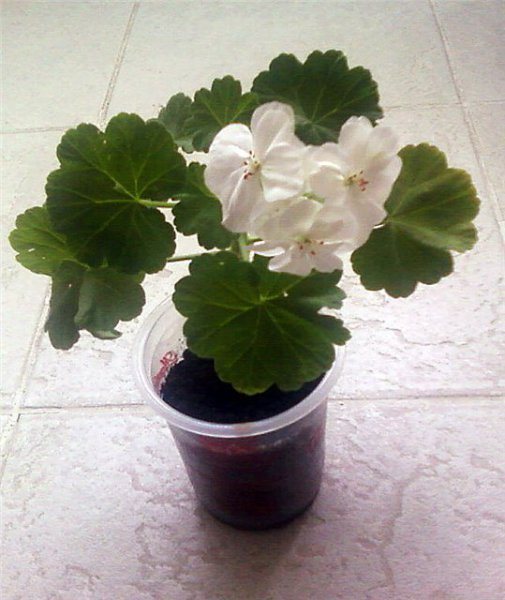

After such watering, geraniums bloom continuously and gorgeous! If the leaves turn yellow, the reasons may be as follows: - if only the edges of the leaves dry out - the reason is a lack of moisture;
- if the leaves are lethargic or rotting - the reason is excess moisture.
In both cases, the leaves may fall off. Exposure of the stem, the lower leaves fall off - lack of light. In summer, geraniums are very fond of living in the fresh air - take it to the balcony or garden, plant it well in the ground.
At first, having survived the stress associated with a change of place, geranium will hurt, its leaves may turn yellow and fall off. But then she will delight you with abundant flowering.
On the street, geranium blooms amazingly, and the bush grows strongly like never before at home.
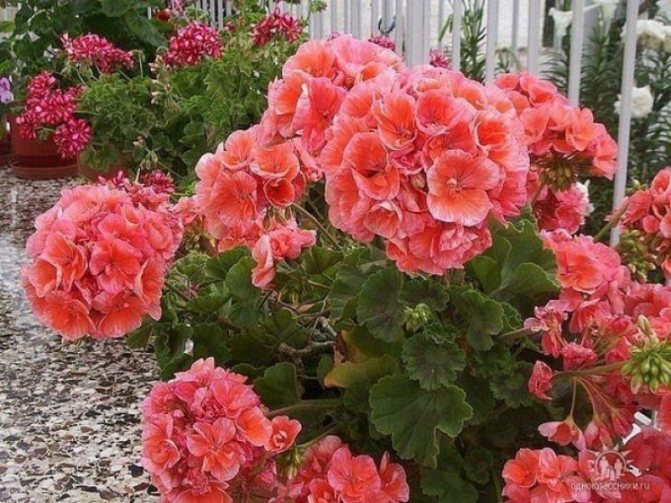

In the sun, sometimes geranium leaves turn pink - this is a normal phenomenon, like a "tan", the plant is no better, no worse.
In autumn, when the weather is cool at 10-12 degrees, geraniums "go crazy" from such a temperature!
You can keep geraniums outside until the frost begins, until the temperature drops to + 2-5. Then it will need to be cut, transplanted into pots and placed in a cool place (10-12 degrees) for hibernation, or, gradually accustoming it to a higher temperature, brought into the room where it will continue to bloom.
How to prune pelargonium correctly?
Earlier in the article, we talked about the reasons why geraniums do not bloom. One of which is incorrect flower pruning. Let's figure out how to properly trim pelargonium at home.
In winter, our plant sleeps, it cannot be disturbed, and in early spring, when the flower wakes up, we need to form the correct crown of the plant.
There are four basic rules that every caring housewife should follow:
- We can begin to form the crown of the bush only after the rooting of the sprout has occurred.To do this, pinch the main shoot - as a result, its growth will stop, and the side shoots will begin to grow actively, plus you will ensure that new flower stalks appear.
- Cutting geraniums should be done only with a well-sharpened knife at the level of the leaf bed. Disinfect your instrument before proceeding. This can be done in the following ways: calcined, treated with alcohol, or simply boiled.
- Remove without regret all the branches that are facing the middle of the pelargonium, otherwise the shoots will thicken near the trunk, and a beautiful lush bush will remain only in dreams.
- Finally, be sure to treat the cuts with chopped charcoal or cinnamon powder.
Dear flower growers, do not forget that you can cut all types of geraniums, but not the royal "person" (!), Which we will dwell on in more detail.
How to do it correctly?
To pinch the geranium correctly, you need to do the following:
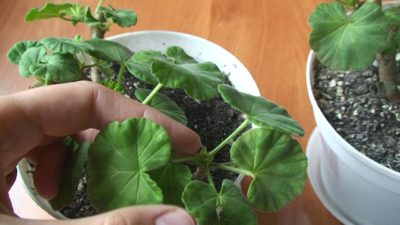

First of all, it is worth carefully examining the shoot, which must be suspended in growth. The largest bud is found on it - this is the growth point, which is responsible for the active development of the flower. If you do not remove the bud at the top of the stem, then it will continue to grow in height, while lateral layers will not form.- We found the main kidney on the top of the head, gently pinch it with clean hands, if the stem is already woody, then you can take small scissors or a clerical knife and cut it off. The operation must be carried out carefully so as not to damage the young leaves nearby and not break the stem.
- It should be understood that after a certain time, the main stem will continue its growth upward, but during the time it adapts, the lateral buds will wake up on it and give branches.
- To form a bush, it is worth watching where the buds wake up first. If the shoots began to grow in the wrong place where you need them, they are removed completely, then the buds you need will begin to give layering.
How to feed?
In the period from the beginning of spring to the end of summer, geraniums need fertilizing. Nitrogen, phosphorus and potassium must be in balance for the simultaneous growth and development of inflorescences, stems, leaves and roots. For example, the mineral fertilizer should not be allowed to contain more than 11% nitrogen, otherwise geranium will not bloom.
In the warm season, it is advisable to put the pot on the balcony. - the abundance of light, together with the difference between day and night temperatures, stimulates abundant flowering. As soon as the inflorescence begins to fade, it is worth breaking off or cutting it off. This way you can achieve a longer flowering.
In winter, during the rest period, indoor non-flowering geraniums cannot be fed, and watering must be done no more than 1 time in 10 days.
Reference! Geraniums are very sensitive to habitat changes. Frequent changes in the location and position of the pot negatively affect flowering.
We suggest you watch a video about feeding geraniums:
Spring pruning features
Well-done pruning in spring for lush flowering is the key to the emergence of new healthy growth and the formation of peduncles. It should be remembered that this manipulation postpones the onset of flowering, so you need to be as responsible as possible when choosing the date of its holding.
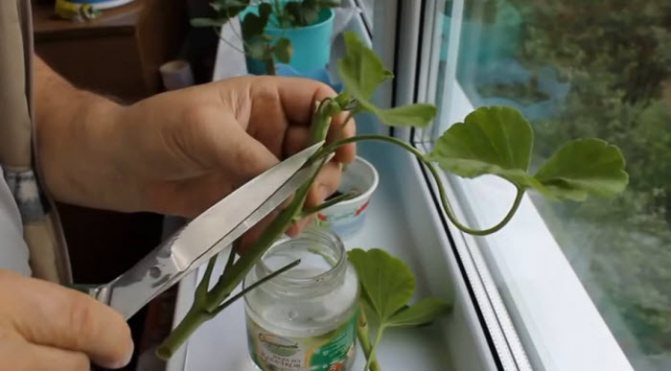

February - March is considered a favorable period for pruning. Pruning large plants is not recommended. You can remove too long, damaged and diseased shoots. Small bushes need to be formed at will, leaving at least two buds on the stem. You should also look at the stems that were cut in the fall. If the cut points are black, they need to be updated.
Cut off shoots do not need to rush to throw away. They can be used for propagation of ornamental crops, since good cuttings are obtained from healthy shoots.
Pruning pelargonium is not a difficult task, but it requires certain knowledge and skills from flower growers.
Having correctly identified the reason for the lack of flowering of pelargonium and correctly eliminating it, it will allow you to enjoy lush flowers for a long time, which will add sophistication to the interior and create warmth and comfort in the room.
Description
Royal pelargonium, or in another way, homemade was bred by English breeders... The large-flowered and glomerular varieties became the progenitors. Royal Pelargonium is not a variety, but a variety that has a huge number of varieties.
The main difference between the noble beauty is its large, collected in an umbrella, flowers 5-7 cm in diameter. Some varieties have fringed petal edges. The color is very varied from white and pale pink to burgundy and purple. In the color variety, only blue-blue and yellow shades are missing.
Most royal pelargonium varieties have dark spots on the top two petals.as well as dark streaks along the rest of the petals. This feature makes it look like a viola (pansy). The leaves of the queen of pelargonium are also special - their edge is not outlined by smooth waves, but has a jagged structure. The bush is compact from 40 to 60 cm. There are varieties with small flowers and a small bush up to 30 cm. They are called angelic pelargoniums.
ATTENTION: A striking feature of this flower is its peculiar pungent smell, however, some varieties exude apple or rose scent, or do not smell at all.
Improper watering
The correct watering regime largely determines whether geraniums will bloom when grown in an apartment. The crane is one of the drought-resistant flowers. In view of this, the presence of excess moisture in the substrate will cause the roots of the plant to begin to rot. This can not only slow down the flowering process, but also contribute to the fact that the flower begins to die.
The problem that the crane does not have enough moisture is less common. However, if you do not water the plant for weeks, while placing it on the windowsill on the south side, the lack of moisture and exposure to direct sunlight will do their job: the geranium will stop blooming, begin to wither, the foliage of the plant will turn yellow.
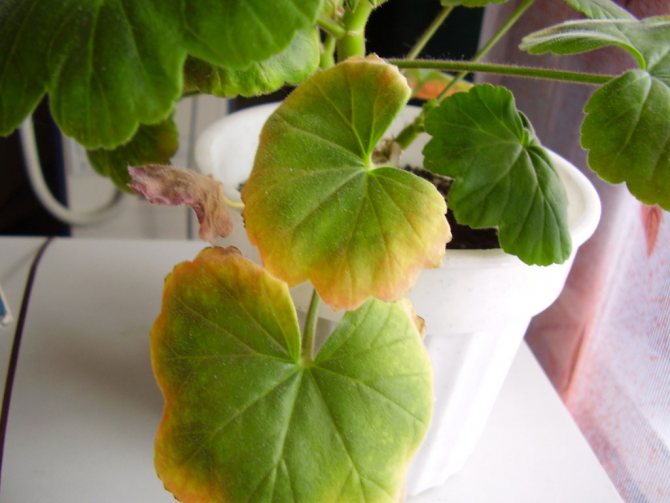

In the spring-summer period, the crane will need one moderately abundant watering per week, in the autumn-winter period - 1 in 2 weeks. It should be borne in mind that before moistening the substrate in which the geranium grows, it is advisable to let the tap water settle for 2-3 hours - so the mineral salts in its composition will settle to the bottom of the watering can, without getting into the soil during watering.
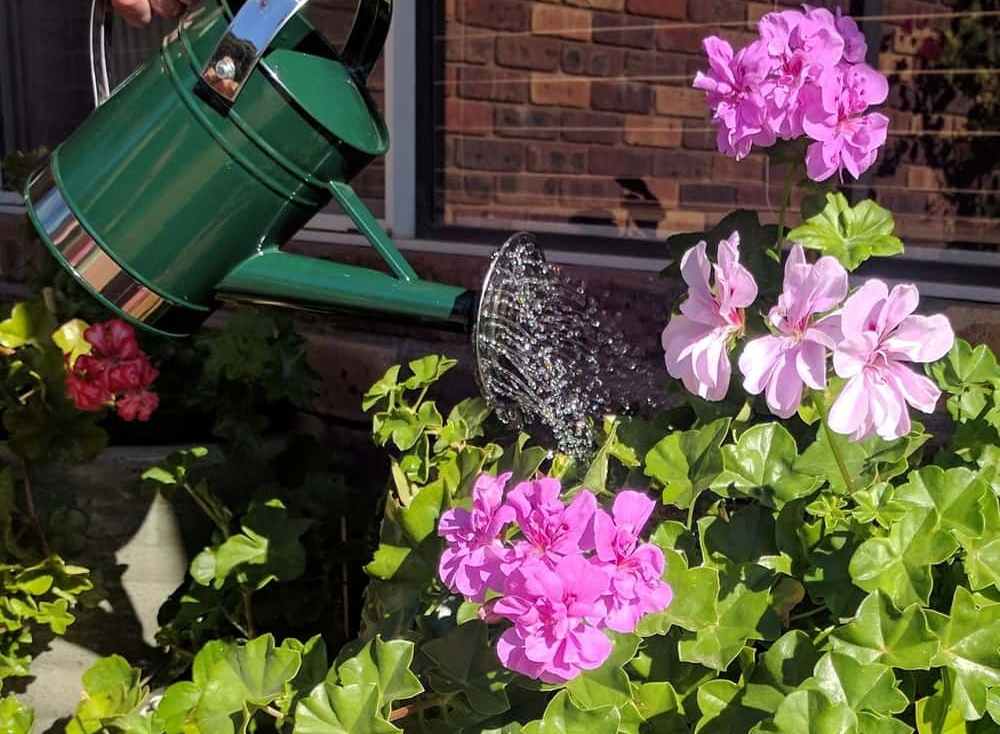

Interesting!
A popular omen says: geranium in the house will help to arrange personal life and financial well-being.
How to stimulate the bloom of indoor geranium?
A florist concerned with the problem of how to make geraniums bloom must create the appropriate conditions for the plant in which it will be forced to strive to form buds. Experienced florists are sure that the bush will definitely throw out flower stalks under the influence of stress.
"Stress" temperature regime
An excellent stimulator of subsequent flowering will be a cool wintering of the bush with the creation of restrictions on nutrition, irrigation. To this end, you will need to remove the plant from a warm room. The temperature indicators recommended for geraniums during this period should not exceed + 13 ... + 14 ° С. Royal, ampelous plant varieties can be placed in conditions: + 10 ... + 12 ° С.
Having resorted to this method, it is worth counting on the formation of peduncles, on which 6-10 buds will form at the same time. In the spring, you need to plant a flower on the balcony. At this time of the year, it is still quite cool here at night, and hot during the day, which will be an excellent impetus for the start of flowering.
Feeding geraniums with iodine
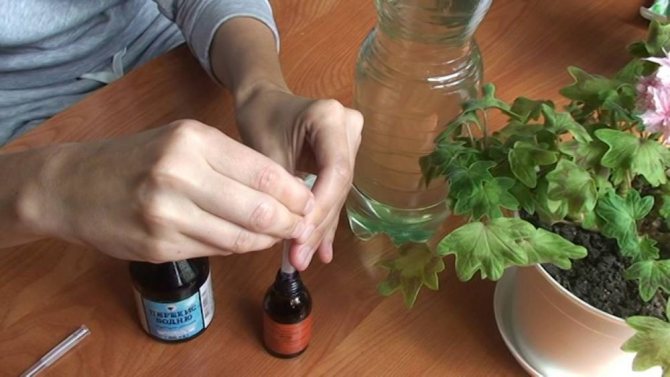

The simplest, most economical way to provoke geranium flowering is considered to be watering with a solution of pharmaceutical iodine. A limited amount of this drug is added to rainwater or settled water. Some florists practice light heating of the irrigation fluid. The solution is prepared as follows: iodine (1 drop) is added to water (1 l). In the case when the plant is very weakened, the amount of the drug can be increased to 3 drops. The solution is thoroughly shaken to distribute the iodine evenly.
Watering with such a product directly under the root of the plant is not encouraged. It is better to add the nutrient liquid to the moistened soil near the side walls of the pot. About 50 ml of solution is poured under one bush. Excessively frequent dressings with iodine are not encouraged, as they can cause damage to the roots, flower disease. Nutrient watering is carried out a maximum of 1 time in 3 - 4 weeks.
Pruning and pinching
In the springtime, it is imperative to prune the shoots. This will ensure an increase in the number of inflorescences laid. Correction of annual varieties is carried out only when absolutely necessary. The stems of perennial plants are regularly pruned.
In order not to ask the question later: why the geranium does not bloom but the foliage grows and the flower stretches out, the bush must be started to form from an early age. Thanks to this, you can count on the growth of a large number of lateral branches, peduncles. As a tool, it is recommended to use only a sharp knife that has been subjected to preliminary disinfection.
Experienced flower growers advise pinching geraniums with well-washed hands. This will exclude the introduction of infection from other crops. Places of cuts will need to be processed using cinnamon powder, charcoal.
In autumn, it will be necessary to remove wilted inflorescences, stems, leaves. In anticipation of frost, the main stems of the bushes are shortened by a third.
In order for the plant to show lush flowering next summer, you can get rid of the buds formed in winter.
Possible errors and their correction
When pinching geraniums, a very important condition must be observed. You cannot pinch all the upper shoots at once, some of them must be left intact. The role of these shoots is that they will take up the bulk of the nutrients, preventing these new shoots from appearing prematurely.
But if you still unsuccessfully removed more high points than you need, do not be discouraged.
Reference. Remove new shoots by burning these places with brilliant green until the upper buds reappear in the right places.
When does it release inflorescences and how long does this period last?
If the geranium is located on a loggia or windowsill and receives enough sunlight, flowering begins in early spring and ends by mid-winter. Then the plant rests for 2-3 months and gains strength for a new flowering. However, there are varieties that are capable of producing new inflorescences all year round.
Reference! Geranium is very responsive to proper care. Any variety can be made to bloom for a long time and magnificently, following simple rules.
Features of flowering During the flowering period, geranium actively spends energy that it receives in the process of photosynthesis. Mineral substances are also consumed: nitrogen, potassium, phosphorus, iodine, salt.
Geranium throws out peduncles one by one... When one inflorescence begins to fade, another actively blooms. So geranium provides uninterrupted flowering for several months. A plant can simultaneously have from one to one and a half to two dozen inflorescences - it depends on the nutrition of the plant and its age.
Fertilizers for geraniums
Why gloxinia does not bloom at home
The use of fertilizers for geraniums is one of the stages of care.Top dressing is necessary, first of all, for the lush flowering of the plant. Also, fertilizers increase the protective properties of pelargonium, which are necessary for the fight against pests and fungi. To know how to feed geraniums, it is better to study the types of fertilizers and their properties.
Remember! Fertilization is not required during the dormant period of the plant. You can not feed if the flower has been in the sun for a long time. The heat is a kind of stress for him. Therefore, before the procedure, you need to transfer the geranium to the shade and give it a rest.
Top dressing with iodine and peroxide
A few decades ago, they knew how to feed geraniums for abundant flowering at home. We used the means always at hand: iodine and hydrogen peroxide. The solution should be watered the plant once a month, it is better to do this in the morning or in the evening. This is a popular method that has proven its effectiveness over the years. For cooking you will need:
- water - 1 liter;
- iodine - 2 drops;
- hydrogen peroxide - 1 tablespoon.
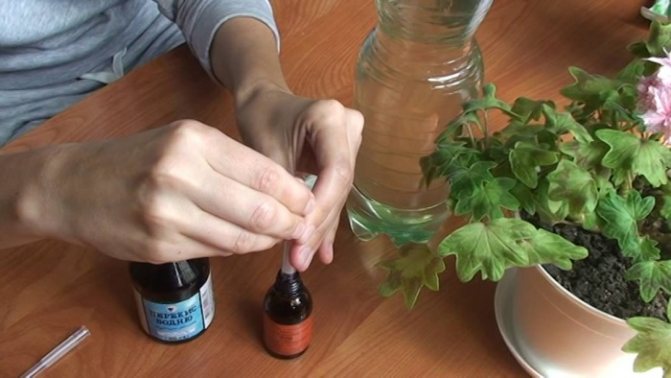

Top dressing with iodine and hydrogen peroxide
Such feeding not only stimulates the growth and flowering of geraniums, but also protects against pests and fungal diseases. In addition, after cultivation, the soil becomes looser, saturated with oxygen.
Vitamin feeding
Vitamin feeding for geraniums for flowering is carried out from the beginning of March. The plant requires nitrogen, so it is better to add fertilizers to the soil, in which it is present. B vitamins are also used. They are usually contained in ampoules, which must be dissolved in water. Vitamins B1, B6, B12 are used. They feed them in turn. For three weeks, once every few days, you need to fertilize with one vitamin, diluting the ampoule in two liters of water. Then they are replaced with another and act according to the same scheme.
Organic feeding
Organic dressing is rarely used. It must be used carefully, if the proportions are not observed, the plant may die.
How to fertilize geraniums using organic products:
- cow dung;
- bird droppings.
Raw materials must be diluted in water and introduced into the soil. This method can be used no more than once every three years.
Despite the fact that geranium is considered an unpretentious plant, it must be looked after. Only the correct lighting regime, watering and timely care will help give pelargonium a blooming look. We must not forget to feed the plant, replant it if necessary, then the buds will appear every season, and the leaves will remain fresh and bright.
When and how should the pinching be done?
It is necessary to pinch pelargonium after 4 leaves have appeared, provided that it was grown from seeds. In the container where the flower grows, a small stalk of geranium has formed, which has grown one or two leaves. The flower is still quite tiny, but pinching is carried out to increase the volume of foliage and prevent the formation of a bare top. If you missed the moment when the pelargonium threw away its first foliage, do not worry, because the deadline for pinching is the seventh leaf, but not later.
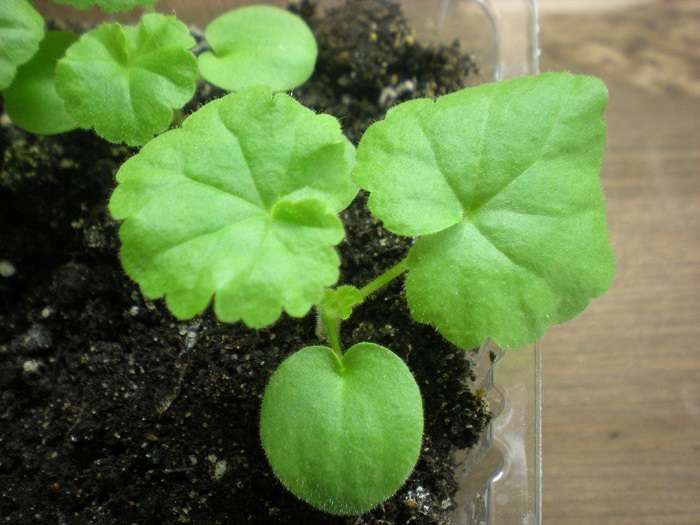

If the geranium has grown from the cutting, then you should not try to pinch the leaves too early, you need to wait until the eighth leaf appears, and then act. But follow closely the development of the flower, because by missing the tenth leaf, you will only harm the plant.
The essence of the procedure is to remove the growth point of the shoot, which stops its growth in height, as a result of which it branches. If you notice that the branches do not grow from the root system, but from the bosom of the upper foliage, then remove them urgently or let them grow to four nodes and pinch again. The most suitable time for pinching is considered to be the second half of February and the first half of March.
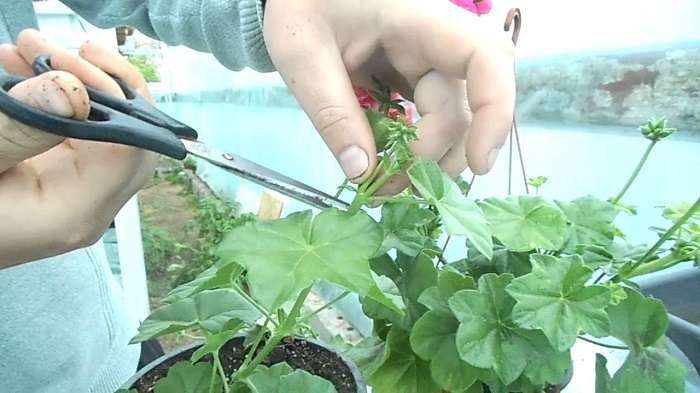

Algorithm of actions during the procedure:
- Pre-inspect the upper shoots and find the growing point on them - the largest shoot bud, which is responsible for the active development of the flower. If this point is not removed in a timely manner, the begonia will grow in length and prevent the formation of a side branch.
- Once you find an active kidney, gently pinch it off. For tighter, stiffer shoots, use instrumental material. This is done so that the geranium does not stretch and bloom well. During the procedure, you need to ensure that the adjacent young foliage does not wrinkle, and try not to break the main stem of the shoot.
- After the procedure, the stem does not finally stop stretching upward and after a while it begins to stretch again. And thanks to the pinch, the buds on the side will have time to bloom and give fresh sprouts.
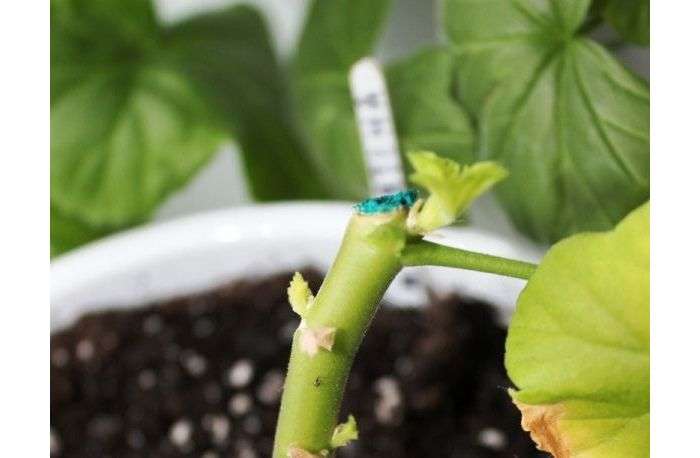

Recommendations:
- When pinching is complete, move the geraniums to a warm, sunny location. Young shoots need a lot of light to grow quickly and vigorously.
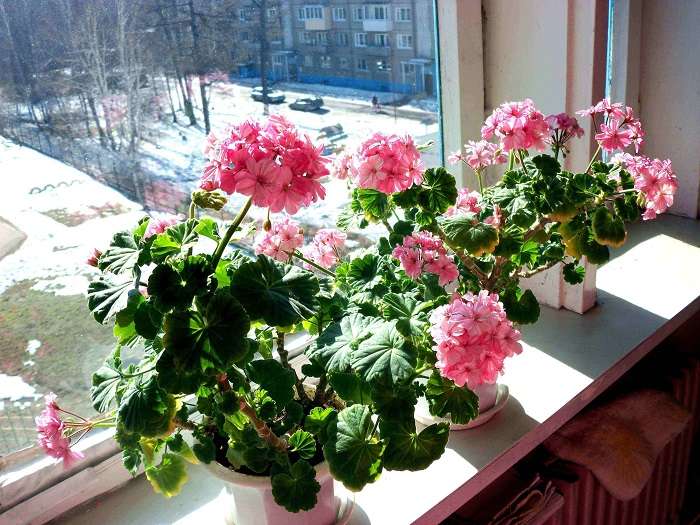

After pinching:
- Provide direct sunlight during the spring season.
- In the middle of the growing season, the plant should be moved closer to the window and the room temperature should be observed. A rapid drop in temperature is not scary, because soon the spring will be warm. But the stuffy air is a terrible enemy of your pet. When it gets warmer outside, ventilate the room.
- Water the flower evenly and in a timely manner, get rid of excess water in the pan, which leads to rotting. So it's better to underfill than overflow.
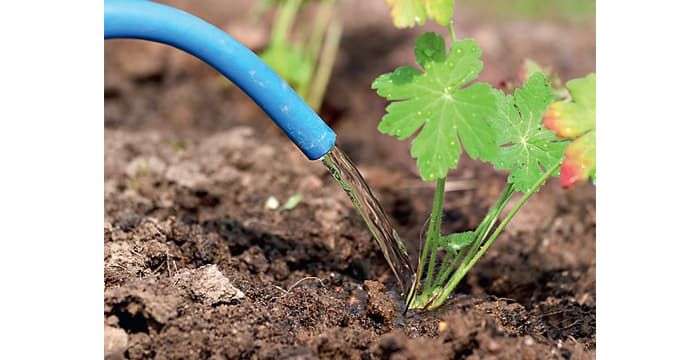

Diseases and pests
A common reason for the lack of flowers is a pest on the crop or rot. The causes of rot: improper watering, high humidity in the room, high or low temperatures. But pests can simply live in the ground that was used for planting crops or is located on neighboring flowers. Often, if a plant is transferred outside in summer, it can pick up a pest there.
Developing in a pot with rot, a pest, the culture spends a lot of energy on resistance to their influence, restoration. Such geraniums will not bloom until the problem is fixed. For pest control, high-quality insecticides are used ("Kemifos", "Actellik", "Karate Zeon"), and fungicide ("Fundazol", "Ridomil", "Oksikhom") will help against rot, but it is advisable to first transplant the plant into new soil and adjust watering, temperature, humidity, otherwise there will be little use from processing.
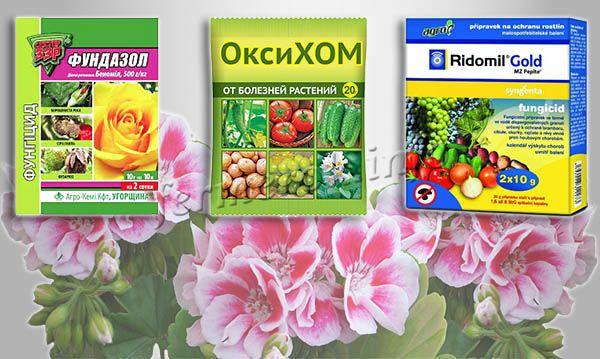

Fungicide will help with rot
Photo
If you follow the step-by-step instructions for pinching a plant, it will look like the photo below.
Irregular pruning
It so happens that geranium stops blooming due to the fact that the flower has an excess of old leaves and stems. The plant does not have enough strength to set buds, because it needs to provide its vegetative parts with nutrients and moisture. Pruning can be done in both spring and fall. However, it is advisable to give preference to the time in which all living things are preparing for rest. It should be carried out as follows:
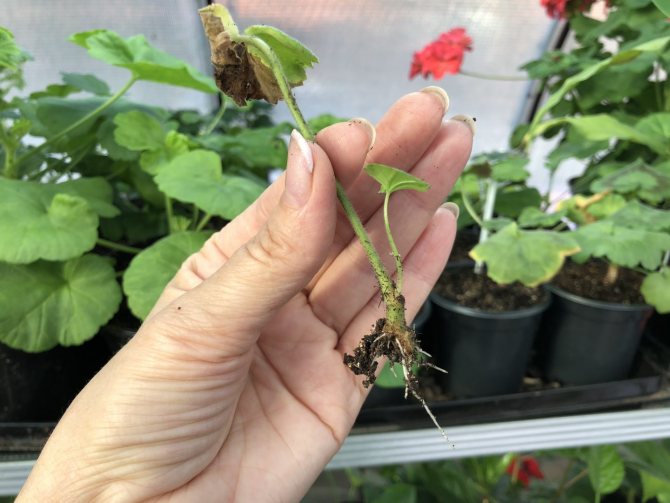

- Remove all inflorescences, wilted leaves and stems;
- Form a bush by cutting off excess shoots;
- Shorten the main stem of the plant by one third of the entire length.
Read:
14 interesting facts about fish
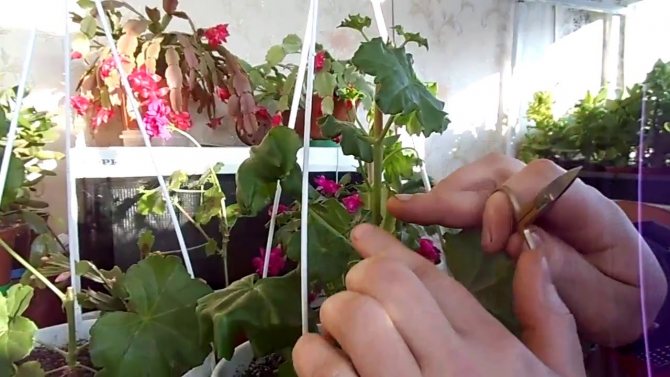

You should not prune the crane in summer or winter: in the cold season, the flower is dormant. Geraniums can die under excessive stress. In the warm season, the plant is in the flowering phase; it is undesirable to deprive it of its vegetative parts.
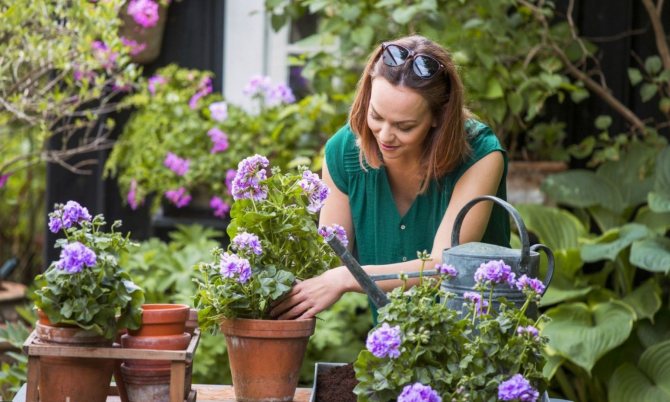

Having considered the possible reasons why the geranium stopped blooming, you can help the crane to set buds. To do this, it is worthwhile to carefully study the conditions in which the plant grows, and eliminate factors that can slow down its growth.
Useful video
Pinching pelargonium. How to form plants for bushiness:
We recommend that you familiarize yourself with our other articles that will help you in caring for room geraniums at home and in the garden:
- When and why to plant a flower?
- How to transplant a plant at home?
- What should be the composition of the soil for geraniums?
- How to find the right pot?
Instrument preparation
Before preparing the instruments for pinching, you need to understand why and why we are doing this? How important is trimming and pinching? Are you wondering why geraniums are drawn? If you follow all the recommendations and rules, then the methodical pruning of pelargonium started on time will:
- Cause the appearance of shoots on the sides.
- Form new inflorescence rudiments.
- Give the flower a neat, even shape.
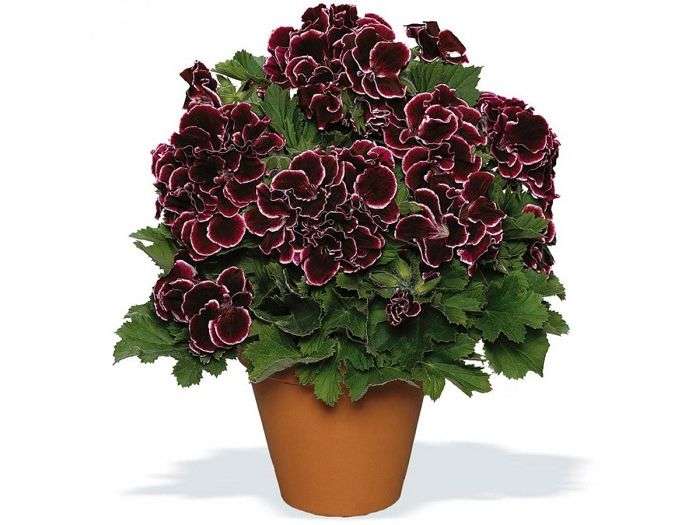

- Make the flowering period longer and more stable, and the flowering itself more lush.
- Help to obtain high-quality planting materials for plant propagation.
- For the procedure, we need manicure scissors, if there are none, then take a paper cutter, it has a thin blade that is great for removing excess on vegetation.
- Be sure to disinfect the material. Perfectly removes germs from simple alcohol. If it is not at hand, then use hydrogen peroxide as an alternative, which will also do a good job of the task.
- It is possible to carry out the pinching with your hands, but nevertheless it will be more accurate if you have the proper tool.
The lateral stem should not be expected to elongate in a season or two. The peculiarity of geraniums is that this flower very rarely releases lateral shoots without human intervention, although each node contains dormant buds. Cutting a flower just helps these buds to awaken and form new shoots, as well as plant flower buds.
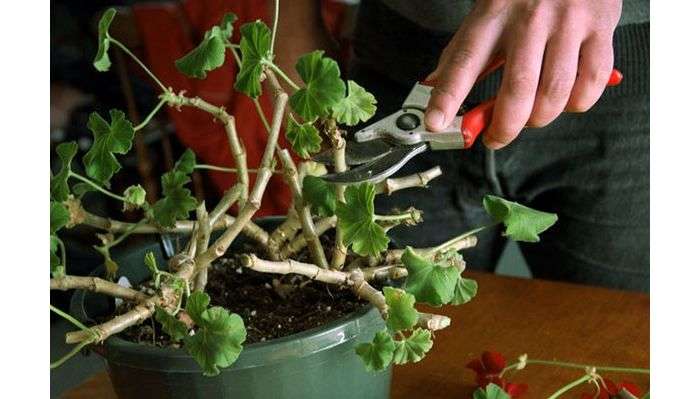

Now you can directly start preparing the tools.
Geranium stretches but does not bloom
We recommend reading our other articles
- Why violets don't bloom
- Top dressing of cherries in spring
- Raspberry variety Golden domes
- How old do horses live
Most often, geranium begins to grow vigorously upward at home if it does not have enough light. This can be observed at any time of the year. To prevent this from happening, it is necessary to correct the lighting, put the pot on a lighted windowsill or supplement it with a phytolamp in winter, for example.
The second reason for stretching shoots in the absence of flowering is a large pot. Geraniums don't need much space. In a large container, it builds up the root system and greenery, but almost never blooms. But if you choose a small pot for culture, then the flower, on the contrary, will begin to bloom.
Interesting!
To provoke a beautiful flowering, you can plant several geranium flowers in one container with a distance of up to 5 cm.When competition appears in space, geranium releases flowers, and even its foliage becomes more saturated in color.
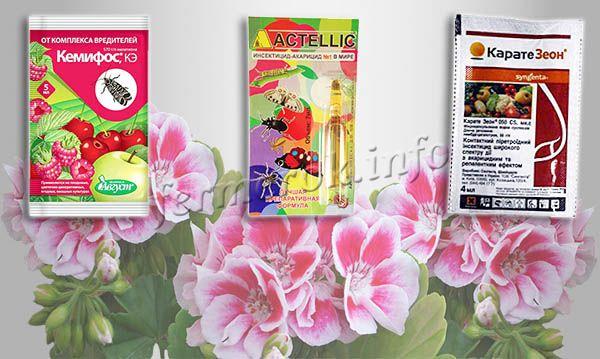

Quality insecticides are used to control pests
Correct pruning
Pruning geraniums is a key step in producing lush and beautiful flowers. Neglecting this process, we get a situation when the shoots pretty soon begin to stretch out, become bare, and the number of inflorescences decreases and the flower becomes shapeless.
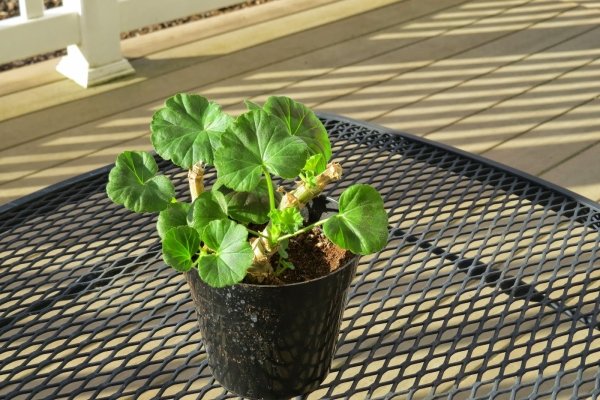

It is necessary to carry out pruning of geraniums constantly and regularly in order to:
- a compact and even shape has been formed;
- lateral shoots appeared;
- flowering was more abundant and lasting.
Geranium rarely shoots laterally unless lateral buds are awakened by pruning. Such manipulation should be carried out with a disinfected sharp blade, or use a clerical knife. It is better not to use scissors, as the shoot is bent and the tissues are disturbed at the cut site.
The location of the cut is chosen above the leaf node, which is directed outward. So the shoots will become freer, and the crown will be less dense. Young stems can simply be pinched gently without pruning. The cut site is treated with activated carbon, and after the procedure, the plant can be watered with a nitrogen-containing solution, which will lead to the accelerated appearance of greenery and shoots.
You can prune at any time of the year, but following some recommendations:
- Autumn pruning carried out when the inflorescences fade, and new peduncles have already formed. Dried stems, withered flowers, dry leaves are cut off. Elongated, bare stems are shortened, which spoil the appearance of the bush. Before the winter dormant period, the plant is shortened by a third. With proper wintering, it forms healthy growth. You can carry out autumn pruning until December, after the plant is left alone.
- Spring pruning held in late February, early March. Pruning later will cause the plant to flower later than usual. Extra weakened stems are cut off, 3 buds are left below.
Heat
The crane does not tolerate high temperatures: the plant begins to wither, stops growing and blooming. In the autumn-winter period, geraniums are in the resting stage - the optimal temperature regime for keeping a flower is 15 ° C. Providing the crane with such an environment at home is not always possible, so it will be appropriate to place the geranium on a cool window.
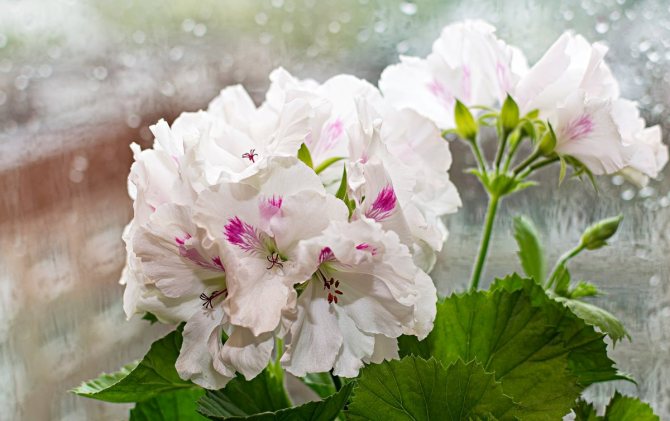

Read:
6 most expensive dogs in the world
In the spring-summer period, it is considered useful to take a flower to the balcony - fresh air has a positive effect on the flowering of geraniums.
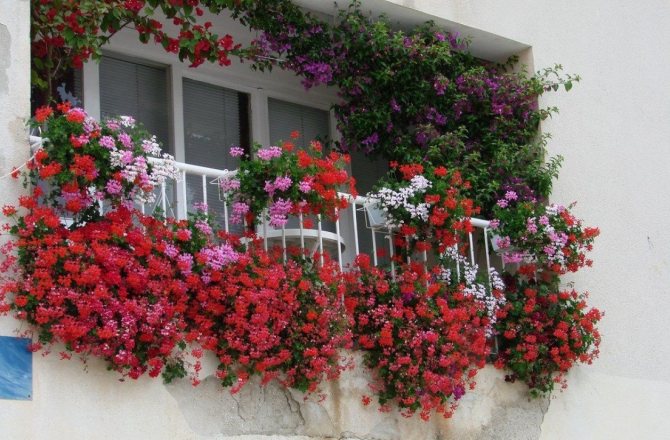

At the same time, it is undesirable to leave the crane near an open window for ventilation in winter - this can lead to frostbite of plant tissues. In case of severe hypothermia, the flower will need to cut off the dead leaves and roots and transplant it into a fresh substrate.
Garden geranium does not bloom
Spectacular perennial garden geranium is considered an unpretentious, shade-tolerant, drought-resistant, frost-resistant crop. This plant, like the indoor plant, may sometimes have problems with bud setting, the flower does not bloom for a long time. There are several reasons why geraniums stopped blooming, gardeners distinguish several.
Bushes planted in a brightly lit flower bed, suffering from a lack of moisture, may not please with flowering. It is worth noting that in natural conditions meadow geranium prefers to stay in an openwork shade, in partially illuminated places. This example is a demonstration of the dislike of members of the geranium family for the bright sun.
Under the strong influence of ultraviolet radiation, plants make every effort to retain moisture - their leaves curl, decrease in size, acquire a purple or reddish tint. On the stems, quickly drying nondescript, single flowers can form. The way out of this situation will be to transplant the bush to a more acceptable place.
A significant obstacle to flowering will be damage to the roots of the plant by the wireworm. Having identified signs of wilting in plants in a flower bed, you will need to dig up one copy and examine its root system. After making sure that the cause of the poor condition of the geranium is the wireworm, you need to treat the plantings with Aktara.It is also allowed to dig up all geraniums, cleanse their roots from pests, place them in an insecticide solution for a certain time, and plant them on a new site. The soil where the bushes used to grow is treated with the same agent.
Open ground transplant
There are two ways to transplant geraniums into open ground with cuttings:
- At the end of May, cut the cuttings from the bush, dip in a solution to stimulate growth, apply ash or coal to the cut and plant in the ground. Make a well for watering near the planting site.
- Cut cuttings after May 10 are placed in water for 14 days. Then they are planted in the ground.
After transplanting, the plant begins to bloom in a month and a half. Until the fall, the bush will take root and will be able to endure the winter under the covering material.
You can transplant geranium with bushes in late May - early June. Before planting, the pot is well watered and the flower is divided into separate bushes with a stem and leaves. They are planted in wide pits, watered abundantly with water. Transplanting with this method promotes flowering after 2-3 weeks.
It should be borne in mind that geranium grows well both from above and by roots, so you need to choose a place away from neighbors.
Transplanting geraniums during flowering is not recommended. We must wait until all the flowers have disappeared.
Mr. Dachnik recommends: advice from professional gardeners
In order for pelargonium to bloom, it is required to follow a number of simple rules that provide the flower with normal living conditions:
- Watering should not be very strong. Geranium does not like excessive moisture. On warm summer days, this is done much more often than during the winter months. The top layer of the soil serves as a signal if it has dried out in the pot one centimeter deep. This is easily determined with a special stick.
- Water the dried soil from a bottle with a narrow neck. Water is poured near the sides of the pot, being careful not to touch the stems and leaves. Any excess water accumulated in the pan must be discarded.
- Geranium does not like frequent spraying. Only in dry weather, when there is an intense heat, the leaves are moistened using a spray bottle, carefully spraying water.
- To achieve flowering pelargonium, watered with water purified from harmful salts. To do this, you need to let it settle for two days. Sometimes a charcoal filter is used. The liquid should be warm. From cold watering, the plant begins to ache, the roots rot.
- The flower must be fed during flowering. In winter, when the plant is dormant, this is not done. To get a lush crown, it is better to add phosphorus-containing compounds sold in specialized gardening stores.
- To obtain long-term flowering, it is necessary to constantly cut the stems, not allowing the geranium to grow in height. When the stem is pulled up, the flower inflorescences will look faded, they will lose their natural beauty.
- In order for pelargonium to stop stretching, it is necessary to cut off excess branches, remove unnecessary leaves. This operation will help the plant build up the strength to bloom with colorful flowers.
- Repotting should be done before flowering begins, or when it ends. It is strictly forbidden to do this during the formation of new buds.
- A clay pot is considered ideal for transplanting. This material allows air to pass through, so the soil will be constantly ventilated, the root system will not rot.
Ground, correct landing
An important rule when choosing soil for geraniums is that the soil is loose, well-drained. Also, it must be necessarily fresh, i.e. not previously used by other plants. When buying a ready-made mixture, you can stop at the soil for flowering indoor plants or universal, so that peat is present in the composition. Then you need to add perlite, river sand and vermiculite to the mixture. Mix everything thoroughly, and can be used for transplanting pelargonium.
When there is no certainty about the quality of the purchased soil, you can keep it in the cold for the winter in order to get rid of all unwanted inhabitants. But if this is not possible, then the transplanted plant should be kept in quarantine for about a month.
How to care for blooming geraniums
Geranium blooms from spring to the very frost, and some species bloom in winter. For abundant flowering, it is necessary to provide food and sunlight, proper watering, and, if the plant is in the garden, weeding from weeds, cut off the faded inflorescences in time. By carrying out these simple procedures, you can ensure that the geranium will bloom for a long time.
In the next video, Alisa Bartova will tell everything about the correct content of pelargonium in her program "My Home Greenhouse":
Having received good and proper care, geraniums will gladly delight the owners with flowering and protect the house from quarrels and disagreements, create warmth and comfort. She is able to normalize sleep, calm the nervous system, relieve fatigue. And on the personal plot next to her there will never be aphids.
Potted Geranium Care
Even the most unpretentious house flowers need attention and care. If this rule is not followed, problems with the plant are possible.
Here are the most common mistakes made by a grower that lead to the lack of flowering of indoor geraniums:
- Excessive watering. Pelargonium does not tolerate excess water and "swamps" in a pot. It tolerates minor drought much easier.
- Incorrect temperature conditions. The ideal temperature for a flower is 20 C. A significant excess of this indicator has a negative effect. In winter, a dormant period begins when the optimal thermometer value is 15 C.
- Container mismatch. If the geranium does not fit the size of the container, it starts up new shoots. As a result, all the energy is spent on growing leaves and branches. Small, compact pots are preferred.
- Lack of fertilizers. Pelargonium needs potassium supplements, but organic ones are not suitable.
- Lack of transplant. If the plant has not been transplanted into fresh soil for more than 2-3 years, there may be no flowers.
- Rare pruning. To preserve its decorative appearance, geraniums must be cut twice a year - in early spring and late autumn.
- Lack of light. When localized on the northern windows, the plant starts growing, as a result of which flowering suffers. It is best to place the pot in a well-lit area.
Every grower wants his plant to be healthy. How to achieve a lush geranium bloom? Use the following tips.
Unlike other plants, pelargonium does not require irrigation with water. Without this procedure, the likelihood of getting large flowers increases.
Dose watering
Try to water only after the topsoil is dry. More water is required only in hot weather. The rest of the time, it is enough to add water 1-2 times a week.
In order for the plant to fully show itself in spring, it is necessary to provide rest in winter. During this season, place the container in a cool place where the temperature is 14-15 C. Do not try to force the plant to bloom during the cold season.
Bright lighting
From spring to autumn, pelargonium especially needs good lighting. Bright light stimulates bud formation. You can not be afraid to put the pot on the southern windowsill.
Transplanting outdoors for the summer is an effective way to stimulate lush blooms. If there is no possibility of transplanting, just take the pot out to the loggia or balcony. Moderate temperature contrast promotes flower formation.
Fertilizer
Fertilizer stimulates the growth of large flowers. Do not forget about properly selected feeding.
Small container
In a small container, flowering will start much faster than in a large one.
Pruning
Spring pinching plays an important role for abundant flowering. Light pruning stimulates bud formation.
For hundreds of years, our room guest has shown her character. The best growers have adopted her preferences. Bit by bit, information has been collected on how to make geranium bloom at home for a long time and in large caps.
Amateurs advise more often, but in micro doses to give the plant potassium salts. Ash extract will be the best fertilizer. If you insist a spoonful of wood ash in a liter of water, drain the liquid and use a spoon in breeding for watering, aphids will not settle on the plant. The leaves will be dark green and the roots are healthy.
It is not necessary to water the geranium so that the roots bathe in the water. As soon as excess moisture appears, the plant will stop flowering. If the geranium gets cramped, the dishes need to be changed. When several plants are sitting in one box, the topsoil is replaced with fresh in spring. Geraniums are planted as soon as tightness interferes with the development of bushes.
You can find the best spot for the flower by moving it around the room. But as soon as the buds appear, the plant is left in one place, without even changing the position of the leaves. Geranium will give long flowering for care.
Don't make geraniums bloom in winter. Create conditions for her to relax in the cool, and she will thank you with a summer riot of beautiful inflorescences. In indoor conditions in winter, it must be placed near the window. Even if the temperature is 15 degrees, it will not hurt.
Special conditions must be created for the wintering of the most beautiful plant - the royal geranium. Her flowers are double, the shades are the most unexpected. But she will be able to bloom profusely if in winter she was given a rest at 12 degrees, was not cut and kept healthy. The same conditions are loved by ampelous geraniums.
Royal geraniums cannot be planted in the garden. The hybrid plant is very decorative. This is an indoor culture, it doesn't even need a balcony. When the buds appear, the tops must be pinched so that the plant's strength goes not into growth, into flowering. Faded twigs must be removed.
We offer you to familiarize yourself with: Tomato big orange characteristic and description of the variety
Lovers have noticed that geraniums live for five, in good conditions, up to ten years. However, over the years, the decorative effect of the bush is lost, it blooms weaker. Therefore, by cuttings, you can annually get young bushes that will be fluffy, compact. Pelargonium grown from seeds in the first year will give it a violent flowering.
Everything written above applies to healthy plants, without the slightest signs of diseases of any kind. If the color of the leaves changes, the trunks begin to dry out or blackening near the root, it is not necessary to achieve flowering, to save the plant. Diseases can be:
- physiological, when the conditions of detention are not observed;
- bacterial, viral and fungal;
- associated with the settlement of insect pests.
After the cause of the disease has been eliminated, the plant will become healthy and bloom. Bush care products have been produced especially for pelargoniums. Using them increases the immunity of the pet, which will certainly affect the duration of flowering.
Home geraniums begin to bloom in February or March. If you take care of it correctly, it will delight you with beautiful inflorescences until September. Novice growers often complain that the bush does not bloom during the specified period of time.
The reasons can be different, usually they are associated with improper plant maintenance:
- unsuitable capacity;
- heavy soil;
- improper watering;
- heat;
- fertilizers;
- lighting;
- pruning.
Pot
Geranium is different from other indoor plants. The flower begins to bloom only after filling the entire pot with roots. During this period, it is allowed to transplant the plant into another compact vessel. After adaptation, pelargonium will begin to grow violently.
In the fall, the flower is returned home in containers along with the land in which it was planted in the garden. That is why geranium does not grow.The soil must be replaced with fertile soil available in gardening stores or prepared by yourself.
Indoor geranium is considered a drought tolerant flower. The plant does not like highly moist soil. Therefore, watering must be done when the soil in the pot is dry. Due to the large amount of moisture, the roots will begin to rot, and harmful bacteria may develop. Before watering, tap water needs to be defended, approximately 2-3 hours.
Heat
In winter, when flowering is interrupted, the ideal temperature for geraniums is 15 ° C. It is not always possible to support her at home. Basically, pelargonium is grown on the windowsill, sometimes taken out to the balcony. This is enough for a healthy flower to bloom again in spring.
In the summer months, the plant is best planted in a flower bed. Fresh air has a positive effect on it. Geranium begins to grow rapidly. It will bloom until the cold comes.
Fertilizers
Geranium needs to be fed. The composition of fertilizers should include several important elements, phosphorus and potassium are required. It is forbidden to use nitrogen fertilizing. They cause foliage to build up, resulting in no flowering. Fertilizers are first dissolved in water, then defended. Watered once every half a month.
Lighting
In order for a flower to delight the eye with abundant flowering, it needs a lot of light. Lighting will be sufficient if the window sill is located on the south side. Direct sunlight should not fall on the plant, it must be moved away from the window. With a lack of lighting in the apartment, geraniums can be kept on the balcony.
Pruning
Autumn is best for this procedure. If the flower was constantly in the country, it is cut off before transplanting it into a pot. During rest, a compact bush will get used to new conditions, give shoots, and stretch up. It will bloom again in the spring months.
Sometimes it is not possible to cut the flower in the fall. It is allowed to carry out the operation in early spring.
Transfer
The soil in the pot must always be changed. Due to the exuberant flowering, the earth is being depleted. The flower is transplanted once every two years.
Florists often faced the problem of lack of geranium flowering. Even an outwardly healthy specimen, which is actively developing, releases new leaves, lengthens the stems, and does not form buds. There are certainly reasons for this.
Pelargonium of any kind is very unpretentious, therefore it blooms profusely and does not need complex care. But even healthy geraniums can stop throwing buds. Despite its unpretentiousness, it is important to provide proper care. Only a careful study of the reasons, elimination of errors in the cultivation of geraniums will solve the problem.
The main mistakes why geranium does not bloom but grows:
- The size of the pot is not suitable for the plant.
- The soil has not been replaced for a long time, it has lost its nutritional properties.
- The flower is in a dark place or is overly lit, a lot of sunlight falls on it.
- Waterlogging of the earth.
- Lack of trimming in due time.
- Lack of feeding.
- Unfavorable temperature.
Necessary conditions and care
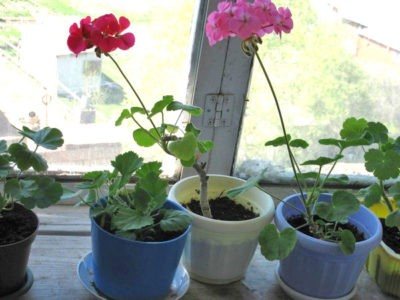

Geranium is an unpretentious plant. But there are some conditions under which it will bloom for a long time and magnificently.
Prerequisites for flowering:
- Adequate lighting.
Geranium loves light and feels bad when it is lacking. The best place for geraniums is an east or south facing window. Before planting geraniums in the garden, you need to find a place with sufficient lighting, protected from strong winds. - Good watering.
Do not overdo it in watering, you must maintain a balance. The plant is resistant to drought, however, excessive drying of the soil should not be allowed. On hot sunny days, or during a period of active heating, it is necessary to water the geranium daily if the soil in the pot is dry. In the absence of heating, on cool cloudy days, it is enough to water once every 2 days. - Comfort temperature.
In a room where geraniums live, the air temperature should not drop below 12 ° C, otherwise the plant will stop blooming. If in winter the leaves of the plant acquire a red tint, this is a clear sign of freezing. You need to move the geranium away from the ice window. - Timely pruning and plucking.
This technique allows you to enhance branching and increase the number of buds.
Important! Air humidity does not affect the health of the plant, so geranium does not need to be sprayed. On the contrary, spraying provokes a rapid wilting of flowers and a delay in the appearance of new peduncles.

